Turkey portion of Eastern
Europe Danube River Cruise
Viking cruise
Summer 2024
This map shows the
Viking river boat passage on the Danube and our Istanbul extension.
Also see Western
Europe - 16 countries in 57 days in 1979 and
Northern Europe journal and
pictures
Table of Contents
Some History
DAY 0 – Sunday June 30 Fly to Hungary
DAY 1 – Monday July 1 Arrive in Budapest Hungary, check into hotel
About Hungary and Budapest, Fishermans Bastion, The Hilton Hotel, Shoes, Mathias Church
DAY 2 – Tuesday Jul 2 Budapest, Hungary City Tour
DAY 3 – Wednesday July 3 Budapest, Hungary – Tour and Cruise Embarkation
DAY 4 -Thursday July 4 Kalocsa, Hungary – Puszta horse show, organ concert
Holy Trinity Square, Horsemen Show
DAY 5 – Friday, July 5 Osijek and Vukovar, Croatia
About Croatia, Church, Osijek, Home Visit, Our Ship
DAY 6 – Saturday, July 6 Belgrade, Serbia City Tour
About Serbia, Kalemegdan Park, Saint Sava Church, Union Hotel
DAY 7 – Sunday, July 7 Golubac, Serbia – Tour Fortress and Scenic Sailing: The Iron Gate
Golubac Fortress, Scenic Sailing, The Lock
DAY 8 – Monday July 8 Vidin, Bulgaria
About Bulgaria, Belogradshik Fortress
DAY 9 – Tuesday July 9 Ruse, Bulgaria City Tour
DAY 10 – Wednesday July 10 - Bucharest, Romania - Disembark - Bucharest City Tour
About Romania, Ceausescu, Filharmonic, Lunch
DAY 11 – Thursday July 11 Bucharest, Romania Fly to Istanbul, Turkey Check into hotel
DAY 12 – Friday July 12 Istanbul, Turkey Topkapi
Topkapi Palace, Spice Market, Spice Market Carts, Cruise
DAY 13 – Saturday July 13 Istanbul Blue Mosque, Hagia Sofia, Hipp, Grand Bazaar
Ablutions, Hagia Sofia,
Blue Mosque, Mausoleum,
Hippodrome, Rug Shop, Grand Bazaar,
Dress Code
DAY 14 – Sunday July 14 Fly from Istanbul to Atlanta - Arrive home 7:50pm.
Back to top
Days 1 through 10 are on the Eastern Europe Danube River Cruise web page.
Back to top
Day 11 - Fly from Bucharest, Romania Fly to
Istanbul, Turkey then check into hotel
Today we fly from Romania to Istanbul, Turkey for our 3-day
extension to the river cruise.
Where is Turkey?
And where is Istanbul?
.jpg)
Where is Istanbul?
There
is European side and an Asian side of Istanbul. One city, two continents. Turks, Muslims , Armenians all live together here harmoniously.
.jpg)
Turkey is
302,455 sq mi (783,562 sq km)
a little bigger than Texas 268,596 sq mi.
.jpg)
Turkey is divided into 81 provinces.
Ankara is the capital located in Ankara province
Turkey border countries
Greece,
Bulgaria
Syria,
Iraq,
Iran,
Armenia,
Georgia
.jpg)
Population Change (From voronoiapp.com)
The population of Turkey has INCREASED 56 %
.jpg)
About Turkey:
Capital: Ankara
Largest city: Istanbul
Official Language Turkish (but at least 10 other spoken languages here)
Ethnic groups (2016)
70–75% Turkish
19% Kurdish
6–11% other minorities
Government Unitary presidential republic
President Erdoğan.
There is a Vice President, Speaker, and Chief Justice
Legislature: Grand National Assembly
Establishment
330 (1694 years ago) to 1453 Roman capital
was Istanbul in the Byzantine (aka Eastern Roman) Empire
330 (1694 years ago) is was the Roman capital by Constantine the Great
330 to 1453 (1123 years) the Roman capital
1453 to 1923 (482 years) Ottoman capital
1923 Ottoman empire fell and the capital moved to Ankara because it is more
internal to the country (and safer?)
xxxxxxxxxxxxxxxxxxxxxxxxxxxxxxx
1299 Ottoman Empire c. 1299
1919 War of Independence 19 May
1920 Government of the Grand National Assembly 23 April
1922 Sultanate abolished 1 November
1923 Treaty of Lausanne 24 July
1923 Republic declared 29 October
1982 Current constitution 9 November
Area
Total 783,562 km2 (302,535 sq mi)
Population
(December 2024 estimate) Turkey: 85,664,944
Istanbul is One quarter of the population of Turkey.
Istanbul population is 20 million (12 million European side and 8 million Asia side)
Ankara (the capital) population is 5 million
GDP (PPP) 2025 estimate
Total Increase $3.652 trillion
Per capita Increase $42,451
xx/font>
PASSPORT must be VALID for six months beyond date of entry One blank passport
page is required for entry and exit stamps TOURIST VISA is NOT REQUIRED for
stays under 90 days
Carry with you
Information:
U.S. Embassy
Ankara
1480 Sok No:1 Cukurambar Mah Cankaya 06530, Ankara Turkey Telephone:
+(90) (312) 294-0000 (emergencies only) Fax: +(90) (312) 232-7472
Contact American Citizen Services Ankara
Consulate:
U.S. Consulate
General Istanbul Istinye Mahallesi, Üç Şehitler Sokak No.2
Istinye 34460 – Istanbul, Turkey Telephone: +(90) (212) 335-9000 Emergency
After-Hours Telephone: +(90) (212) 335-9000
Contact American Citizen Services Istanbul
About Sultans and the Ottoman Empire
Sultans ruled over the Ottoman Empire (also called Turkish Empire) for 625 years (1299 to 1923 – when the state of Turkey was established)
FYI: The word “Ottoman” is a historical anglicisation of the name of Osman I, the founder of the Empire and of the ruling House of Osman (also known as the Ottoman dynasty). Osman's name was the Turkish form of the Arabic name ʿUthmān.
Anglicisation: A linguistic practice of modifying (respelling) foreign words, names, and phrases to make them easier to spell, pronounce or understand in English.
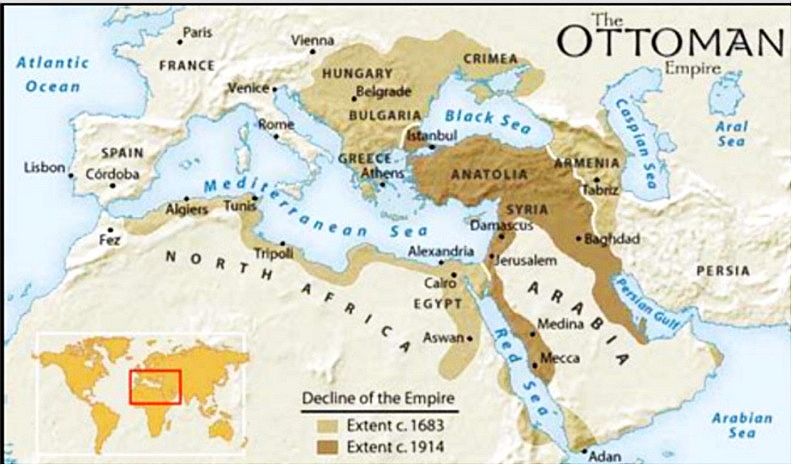
There were 36 sultans from 1299 to 1922 (623 years) and they were all related.
The first sultan named Osman means “ruler”
The tenth sultan was called “Suleiman the Magnificent” . He was an important conquerer.
A boy is circumcised before they become a sultan. Sometimes at 13-14 years old ( not on 8 th day after birth).
There is Circumcision room in the palace.
Then there were three steps that defined the reign of the sultans, as quoted by Turkish historian A. Çağrı Başkurt.
“The first is to take the throne in the palace, the second is to wield a sword in Eyüp [an historic district in Istanbul], and the third is to perform the first Friday prayer in Hagia Sophia.”
One sultan had 120 kids!
A story by our guide: At one time there were 60 boys. Some got sick so only 20 boys left. Two of those boys killed the other 18 boys.
If the son of a Sultan becomes powerful, it was OK for the sultan to kill his son and his brothers. But that changed. So they were put in prison instead of being killed. Crown princes were in prison. When the sultan dies, then you can get out of prison. But that can be a long time. They went mad because in jail so long. 30-40 years in prison.
The Sultan eats from a golden tray. Over 40 foods available. Later sultans did not have an ego so they finally started sharing the food.
They would kill 200-400 lambs and sheep were needed every day to feed all the people . about 4000 people to feed here. 1000 ladies.
Our guide said the “Government killed sultans.” I think what he meant was that there was no place for a sultan in the new government. The Caliphate was abolished in 1924.
Viking
itinerary for today (it was about Bucharest
not Istanbul...):
Admire
stunning architecture and explore an array of world-class museums.
Communism
changed the face of Bucharest and has left in its wake a city brimming with
imposing socialist architecture. Dotted among today’s cityscape are wonderful
art nouveau buildings, ancient churches and monasteries that were rescued from
the bulldozer.
From the
18th-century church Schitul Maicilor to the 16th-century Mihai Vodă Church, it
is best to discover these treasures on foot. Bucharest is also home to an array
of world-class museums, including the George Enescu National Museum, which
features a beautiful oyster-shaped glass awning.
After
breakfast, check out of your hotel and journey to Istanbul Turkey.
My Notes
I set up a 5 am wake up call on the television. So at 5 am, I was impressed with the with the TV slowly fading on and finally illuminating brightly. Very impressive.
Saw this on CNN newsreporting on an
interesting event: The Olive
Oil Wrestling Festival in Turkey. Coincidently the trailer at the bottom
of the screen mentions and 8 million people in Oklahoma....
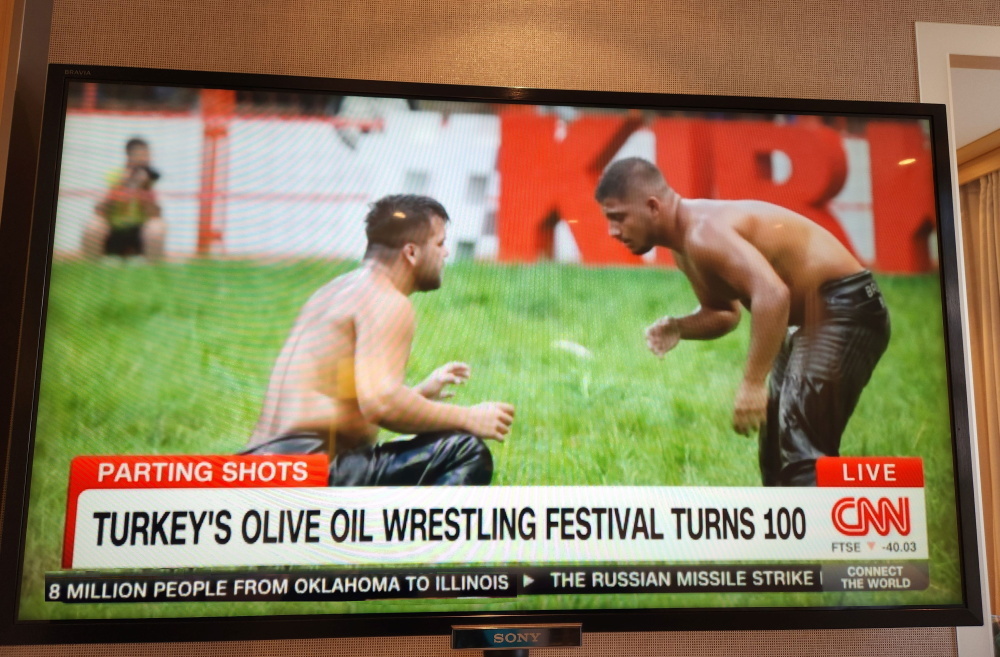
6 am bag pickup.
6:30 am depart hotel.
1 hour 20 minute drive to the Bucharest airport. His long sleeve top is still separate from all luggage and laying on top of his carry on bag which is laying on top of his suitcase. Interesting configuration.
We had a 9:30 am flight departure. Flying time is 1 hour and 35 minutes.
The plane was a 2-4-2 configuration and we had an aisle and window seat together,
but they moved us to an exit row. He had never sat there before and the seat tray and screen is configured a little bit different.
A drink and some snacks on the flight.
Arrive in Istanbul 11:05.
This is a huge airport. 76 million passengers compared to 104 million passengers
in the Atlanta airport.
Our guide said they are building a new airport in Istanbul that will handle 140
million passengers because Istanbul is the center of the world.
.jpg)
From the airport to the hotel it is 1.5 hour drive. Check into the hotel.
Hotel
Conrad Istanbul Bosphorus
Cihannuma Mah Saray Cad. No: 5 Besiktas 90-212-310-2525
istanbulinfo@conradhotels.com Located in the vibrant Beşiktaş district, a short distance from many of the city’s iconic landmarks and shopping destinations,
this hotel combines modern amenities and unforgettable views of Istanbul’s skyline.
Guests can enjoy a cocktail while relaxing on the panoramic terrace at the Summit bar or indulge in Mediterranean cuisine at Manzara.
We will be in this room for 3 nights.
The bathroom is awful. The shower goes all over the toilet. It will be a wet floor all night if I have to get up to pee.
Noon Thursday in the meeting lounge in Istanbul. Viking Host Aliye Secen.
She told us what to expect the next two days.
Do not drink the tap water. Bottled water is available for us here at the Viking deck in the hotel. It is glass bottles so we can only carry a few bottle at a time.
99 Euro is about 1.08 USD and 3,500 Turk Lira. 1 USD = 32 Turkish Lira.
Hotel restaaurant named Manzara is where breakfast is served.
On the 14 the top floor is the Summit Bar.
Leave passport in the room safe.
Get a hotel card.
Internet access choices are “purchase” or “standard 0,00” and enter WiFi code.
Istanbul has an Asian side and a European side: There is an Old European side and New European side. I think we were on the New European.
To get to the water, exit hotel , turn left. Manadan restaurant
is good. You can walk to Gala Tower, Taksim square. To go further, there is no Uber here. Use taxi.
For tomorrow at the spice market he told us to haggle. Use Euro, dollar or credit card. Around the hotel use Turkish money or credit card.
The Boat tour is 2 hours on private boat.
On Saturday for the mosque visits the dress code ladies cover hair and shoulders and knees. Shoes off. Socks are ok.
The Viking itinerary said that tomorrow we were going to Blue Mosque then Hagia Sofia, but our excellent guide knew better. Tomorrow is Friday and there will be 5000 people praying there, so instead we are to Topkapi on Friday.
Notes from our Tour Guide
These note are combination of the talks from our Tour Guide during the two
touring days in Istanbul.
Istanbul means “to go to city” from the Greek name “Istanbollee”.
CRUISE PORT:
There is a new cruise port built 4 years ago. Cost of 1.8 billion
Under the cruise port is an underground terminal for the tour busses.
Today there is not a single cruise ship here. Yay.
Yesterday there were 120 tour buses here and he had 30 people on this tour.
8 years ago there was 11 cruise lines here on the same day . Each ship requires 100 buses, so there were 1000 buses touring Istanbul that day.
We are driving past Roman walls that are being renovated. There is scaffolding and new buildings.
There are no high rise buildings here in old city.
Enter Imperial Gate
1200 USD average salary teacher. In Turkey average salary is 600 USD.
20 percent of paycheck goes to taxes for pension and retirement and medical.
Minimum salary is US is $2000 per month. Here it is 500 a month but it is hard to live on that amount.
“our buying power is less because we earn less”
1 year of military service is required here. $2000 USD and you can buy yourself out of the service. He did that in 2014.
In 1952 Turkey joined NATO.
Turkey does not use Euro because it is not Schengen countries. They need a visa to go to the European countries. Visa cost is 150 Euro
Education is free in Turkey if you get good scores. Private education cost 2-3000
University 3000 to 7000 USD.
At the Istanbul airport the plane taxies for 45 minutes, then you must walk another 30 minutes to get baggage.
“Taksi” sign on the taxi cars here.
One week at an all-inclusive hotel on the coast $1000 USD.
Officially 70% inflation here in Turkey.
In reality it is 300% when you see the changes in prices.
200 Turkish Lira was 140 USD and now it is 6 USD.
200 is the largest bill.
20% of Turkish economy is tourism.
Hazelnut is the top producer here. 70% of the world hazelnut comes from Turkey.
They also produce pistacio, apricot, figs
Turkish coffee is the style of coffee served here.
It is not filtered so there are grounds on the bottom of the cup.
You should stop drinking it before you get to the grounds
You cannot add sugar to Turkish coffee because of the grounds on the bottom of the cup so when you order it, they ask if you want sugar in coffee and that is how they prepare it
Coffee comes from brazil.
They drink more tea than coffee here in Turkey. Tea must be served in a clear container to see the color of the tea.
“turkish delight” is a dessert. Square jelly, starch, and sugar. Now more honey is used, nuts and other things.
Only tourists wear Fez. Turkish do not wear a Fez.
In 1928 the alphabet changed from arabic to latin
Dog that has an ear tag has been neutered. Or a cat with clipped ear is neutered.
1 cup coffee is Starbucks is $4 USD. Very expensive for us.
1 gallon gas about $6 USD.
Uber is not allowed here. If you call an Uber, a taxi
comes and you still negotiate the cost.
There is traffic here. Lots of traffic. Motorcycles zipping between the vehicles.
Dinner :
For dinner Gary and I went to 14th floor restaurant. I had an incredible chicken burger and that was the best meal that I’ve had for the entire vacation. The fries were perfect. Aoli sauce, red cabbage slaw. Perfect.
It’s 7:40 now and a sunset is coming soon over the beautiful harbor view.
Back to top
Day 12 - Istanbul, Turkey - Topkapi, Spice Market, Cruise
Excellent breakfast at our hotel. Anything that you wanted to eat or drink was available. Any food from any continent. Of course I looked for, and found the porridge.
.jpg)
.JPG)
Pancakes with decadent toppings.
.JPG)
Back to top
9:00 am Topkapi Palace Guided Tour
Viking description of the Topkapi Palace Tour
9:00 AM 4 Hours Imperial Treasury and Royal Residence of the Sultan
Explore the huge fortified complex of Topkapi Palace for a glimpse into the opulent lives of the sultans.
This palace on the shores of the Bosphorus was the epicenter of the Ottoman Empire for 400 years. Today, it is a repository for many spectacular treasures housed within its walls, which are surrounded by extensive gardens.
Walk through the Imperial Treasury, housing a vast glittering collection of weapons, ceramics, imperial costumes and jewelry—including the famous 86-carat Spoonmaker’s Diamond and exquisite Topkapi Dagger.
Visit the Harem, the royal residence of the sultan and his family. See where the eunuchs and concubines lived,
and tour the Queen Mother’s rooms. As you stroll, take note of the cupboard doors inlaid with mother-of-pearl and tortoiseshell, and the beautiful blue İznik tiles glazed with floral patterns and verses from the Koran. Afterward, you will return to your ship.
My Notes
Our original Viking itinerary said we were going to the Blue Mosque
and Hagia Sofia today, but it is Friday and our guide said there are 5000 people
praying there on Friday. So they switched the Friday and Saturday tours and we are going to Topkapi Palace on Friday
(today) and Saturday (tomorrow) Blue Mosque and Hagia Sofia on Saturday.
It is 9:15 am and we are on the bus now for 30 minute drive to Topkapi palace.
After the palace, we go back to the hotel.
Rest a couple hours, then At 2:30 meet to go to Spice Market, then from 4-6 pm
on our private yacht on Bosphorus.
We are crossing over the bridge over the Golden Horn
to Old Istanbul.
The Golden Horn bay is 5 miles long.
It goes into the Bosphorus which goes for 20 miles out to the Black Sea.
The Topkapi Palace was the administrative center of the Ottoman Empire
“Top” means cannon “Kapi” means gate, so Topkapi is “Cannon gate palace”
It is 173 acres.
There are four courtyards and Harem complex.
2.3 million square feet (700,000 sq m)
Built 1458-1468 for the Ottoman sultans and their 1000 concubines (4000 people total)
Used for 400 years until 1853. Then the sultans lived in
Dolmabhadce (dol-ma-bah) Palace
1922 for 400 years until the the abolition of the
Caliphate in 1924.
It was never used as a mosque. There are no minarets. It has been used as
an arsenal.
In 1983 Topkapi became a museum.
There were 36 sultans from 1299 to 1922 (623 years)
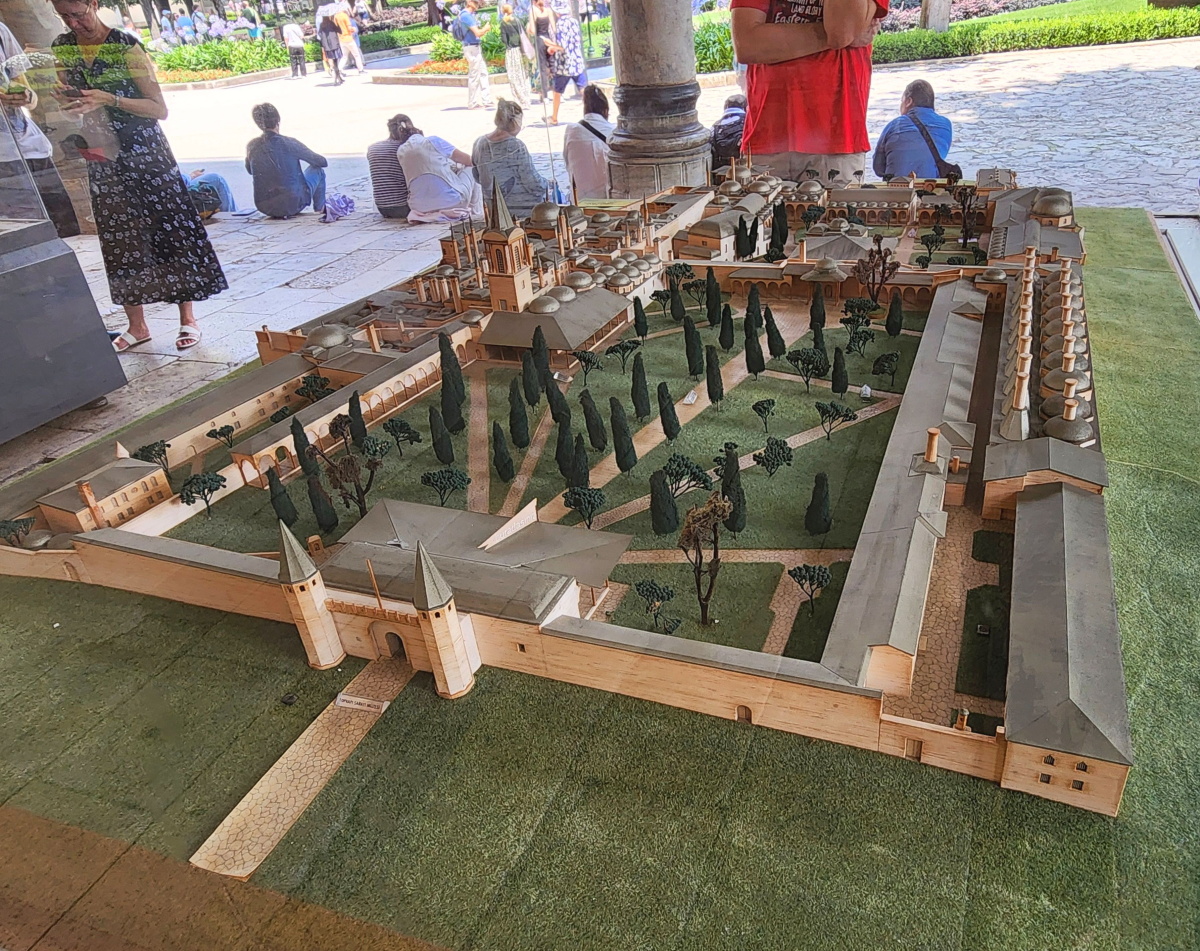
It is 173 acres. 2.3 million square feet (700,000 sq m).
Built 1459-1465 for the Ottoman sultans and their 1000 concubines (4000 people total).
Used for 565 years until 1922.
Circumcision room - circumcision is not on the 8 th day. He is circumcised right before they become a sultan. Sometimes at 13-14 years old.
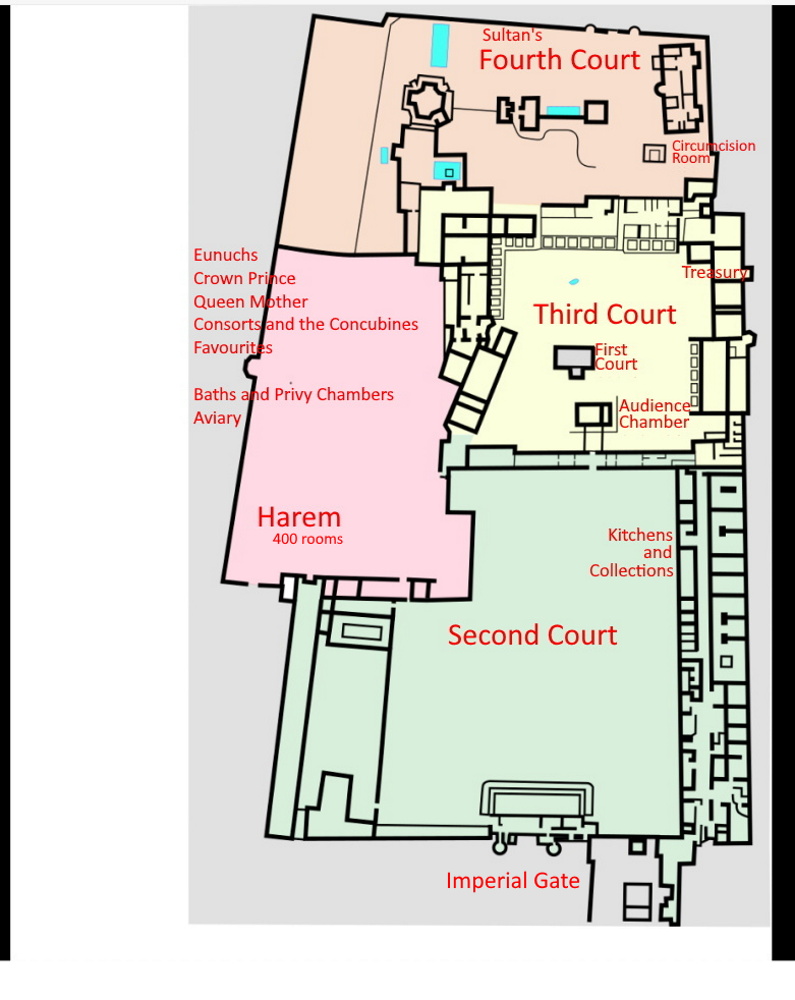
About food
The Sultan eats from a golden tray. Over 40 foods available. Later sultans did not have an ego so they finally started sharing the food.
They would kill 200-400 lambs and sheep were needed every day to feed all the people . about 4000 people to feed here. 1000 ladies.
Here is our excellent guide Ural leading us into the Gate of Salutation entrance
to the Second courtyard of the Topkapi Palace.
The inscriptions on each side of the gate say “God is Great” Mohammed is messenger.
There is not God except Allah”
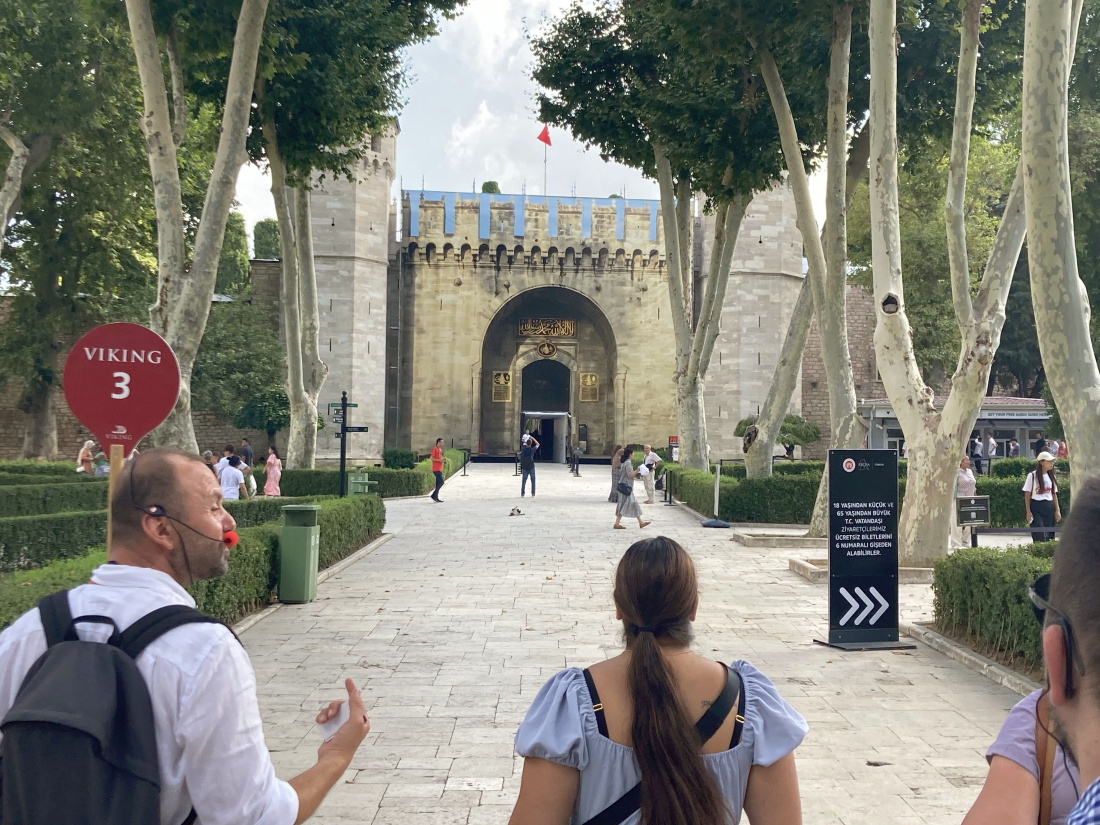
There are four courtyards in Topkapi. The largest is this Second Courtyard
with these grand Sycamore trees
.jpg)
This is Council Square / Justice Square
This courtyard was the center of administration and the ceremonial area for the Ottoman Empire.
On the left side is stables, dormitory for maintenance staff (the “Halberdiers” who carried wood and serviced the palace) a mosque, harem entrance (Carriage Gate of Harem).
On the right side is the Palace Kitchens. The portico would be lined with food to show everyone the wealth and power of the the Ottoman State.
Officials meet 4 times per week to discuss state matters at the Imperial Council and Tower of Justice.
Ceremonies held for
A new sultan’s accession to the throne
Ramadan festivals
Paying the
janissaries (elite deadly army troops and the 1st in the world equipped with
firearms)
Receive foreign ambassadors
The Harem
In Arabic. the word "harem" means "a holy place where not everyone is allowed to enter." It refers to private family life in Islamic countries.
In Ottoman palaces, Harem was the private residence of the dynasty. It was forbidden to the public.
The Harem in Topkapl Palace was the living quarters of Sultan, Sultan's mother; wives/ children and siblings of Sultan.
The purpose of the Harem was to ensure the continuity of the Ottoman dynasty.
Harem ladies were only for the sultan. 1000 ladies lived here.
Entrance to the Harem
%20ByFadiAswad.jpg)
Harem ladies were only for the sultan.
1000 ladies lived here. The Harem has 400 rooms.
Ladies were paid well as servants, concubines, and wifes and they were educated.
Favorite
A women who has some type of relationship with the sultan.
Consort
A higher-ranking woman. An official partner.
Concubine
A woman who has a domestic relationship, but is not his official wife.
In ancient China, emperors could have multiple concubines, but only one official consort at a time.
Wife
The goal of a woman is to get pregnant by the sultan.
If a woman gave birth to the sultan's child, she was granted the title of wife and a private room.
A wife was paid well. After 10 years they are retired and treated well.
Queen Mother
The mother of the sultan has the highest position
with authority and a very comfortable apartment.
The harem includes apartments, turkish bath, a laundry room, a pantry, and a dormitory. Hospital.
This is the Courtyard of the Eunichs
%20wiki.jpg)
The sign said “This dormitory housed the black eunuchs.” It has 3 stories of rooms on each side of the courtyard. Built in the 10th century, burned in 1665, then renewed.
Security was provided by eunichs (and maids were also harem guards).
Our tour guide said “They were not made eunichs here. White and black were purchased.”
.jpg)
My picture of the entrance to the Imperial Council
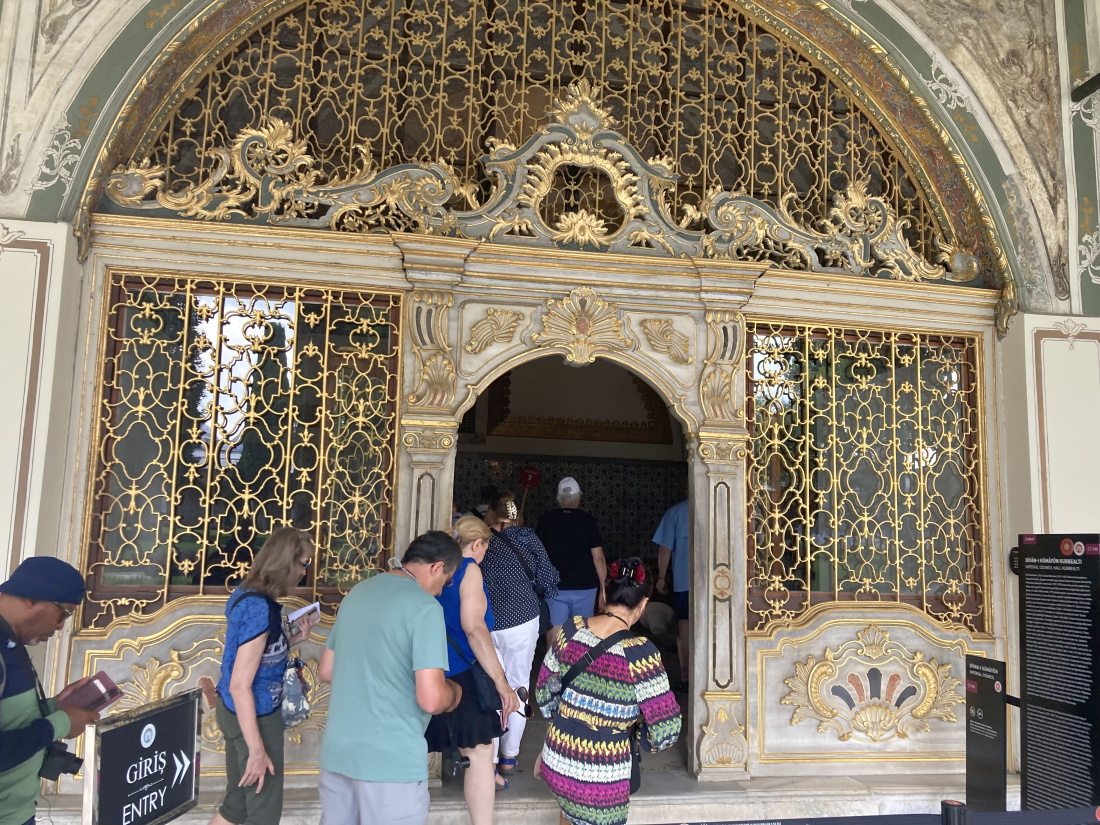
The Imperial Hall with Imperial Sofa or Sultans Throne Room
.jpg)
The Imperial Hall with Imperial Sofa or Sultans Throne Room
Official reception hall of the sultan for the entertainment of the Harem
The sultan received his confidants, guests, his mother, his first wife,
consorts, and his children
Held religious festivals, and wedding ceremonies
After the Great Harem Fire of 1666, the hall was renovated.
The tile belt surrounding the walls bearing calligraphic inscriptions on 18th-century blue-and-white Delftware and Venetian glass mirror.
Gifts:
The gilded chairs from Emperor Wilhelm II of Germany, and clocks from Queen Victoria.
Sultan has a secret door behind a mirror for safe passage to Queen Mother's apartments and to the sultan's hammam (privy,
bathing area).
There are doors to
dining chamber, and the great bedchamber, and his private apartment.
Dome ceiling is the largest dome in the palace
.JPG)
.JPG)
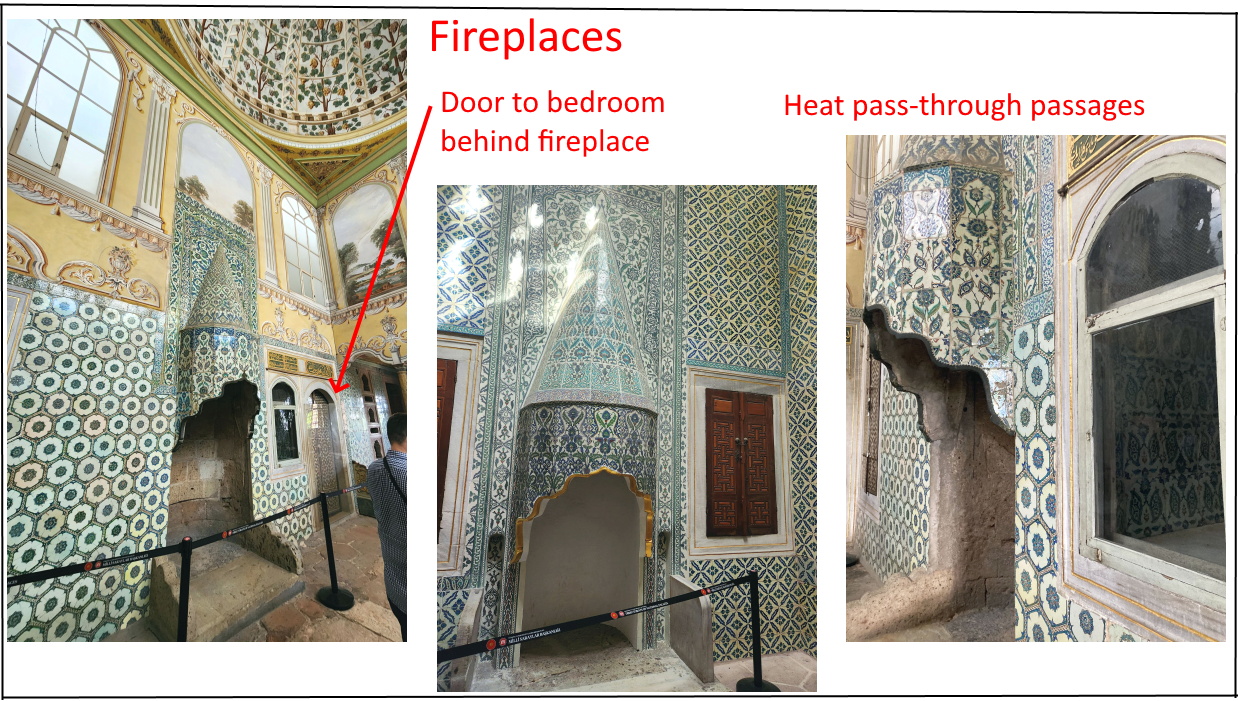
PRIVY CHAMBERS or Hammam (bath house)
.jpg)
The Sign says: PRIVY CHAMBER OF SULTAN MURAD III
Sultan Murad Ill commissioned Mimar (Architect) Sinan to build this privy chamber in
1579 in place of Süleyman the
Magnificent's privy room.
The building had been used as both the sultan's private apartment and his reception hall for centuries.
It's one of the most magnificent structures of classical Ottoman architecture.
Its interior was laid with the 16th century iznik tiles, manufactured in the period in which the art of Ottoman tile making had been at its peak.
The Verse of the Throne from the Holy Qur'an's Surah at-Baqarah is inscribed on the belt of tiles running around the walls in white calligraphy letters on blue background.
The dome's interior and the pendentives are decorated with rumi and palmette motifs that were made using the malakåri technique (decoration made by using paint on plaster reliefs).
The same patterns are also repeated along the dome's guardrail in the form of marble reliefs.
The monumental tombac stove, the fountain built into the wall (selsebil), and cabinet doors which were interlaced with geometric patterns, inlaid with mother-of-pearl and tortoiseshell and attributed to Sedefkår Mehmed Agha, reflect the style of the classical period.
The two wooden and gilded baldachin thrones in the Ottoman Baroque style date back to the 18th century. Below is a large indoor pool.
Throne Verse is inscribed on the belt of tiles running around the walls. White calligraphy
letters on blue background.
The 255th verse of the second chapter of the Quran 2:255.
In this verse, God introduces Himself to mankind and says nothing and nobody is comparable to God.
Considered the greatest and one of the most well-known verses of the Quran, it is widely memorised and displayed in the Islamic faith.
It is said that reciting this verse wards off devils (šayāṭīn) and fiends.
Due to the association with protection, it is believed to shield against the evil eye.
Text and translations
Arabic
ٱللَّهُ لَآ إِلَـٰهَ إِلَّا هُوَ ٱلْحَىُّ ٱلْقَيُّومُ ۚ لَا تَأْخُذُهُۥ سِنَةٌۭ وَلَا نَوْمٌۭ ۚ لَّهُۥ مَا فِى ٱلسَّمَـٰوَٰتِ وَمَا فِى ٱلْأَرْضِ ۗ مَن ذَا ٱلَّذِى يَشْفَعُ عِندَهُۥٓ إِلَّا بِإِذْنِهِۦ ۚ يَعْلَمُ مَا بَيْنَ أَيْدِيهِمْ وَمَا خَلْفَهُمْ ۖ وَلَا يُحِيطُونَ بِشَىْءٍۢ مِّنْ عِلْمِهِۦٓ إِلَّا بِمَا شَآءَ ۚ وَسِعَ كُرْسِيُّهُ'ٱلسَّمَـٰوَٰت وَٱلْأَرْضَ ۖ وَلَا يَـُٔودُهُۥ حِفْظُهُمَا ۚ وَهُوَ ٱلْعَلِىُّ ٱلْعَظِيمُ ٢٥٥
English
255 God: there is no god but Him, the Ever Living, the Self Sustaining. Neither drowsiness nor sleep overtakes Him. All that is in the heavens and in the earth belongs to Him. Who is there that can intercede with Him except by His permission? He knows what is before them and what is behind them, but they do not comprehend any of His knowledge except what He wills. His throne extends over the heavens and the earth; it does not weary Him to preserve them both. He is the Most High, the Tremendous.
The white calligraphy letters on blue background tiles around the wall is the
Throne Verse from the Koran.
.jpg)
Water taps.
Our guide said that the water was not for drinking but to make white noise to cover other noise in the palace.
And so other people could not listen.
There are many water taps around the palace.
.jpg)
Topkapi
Privys. Sultan's is behind a gilded grill
.jpg)
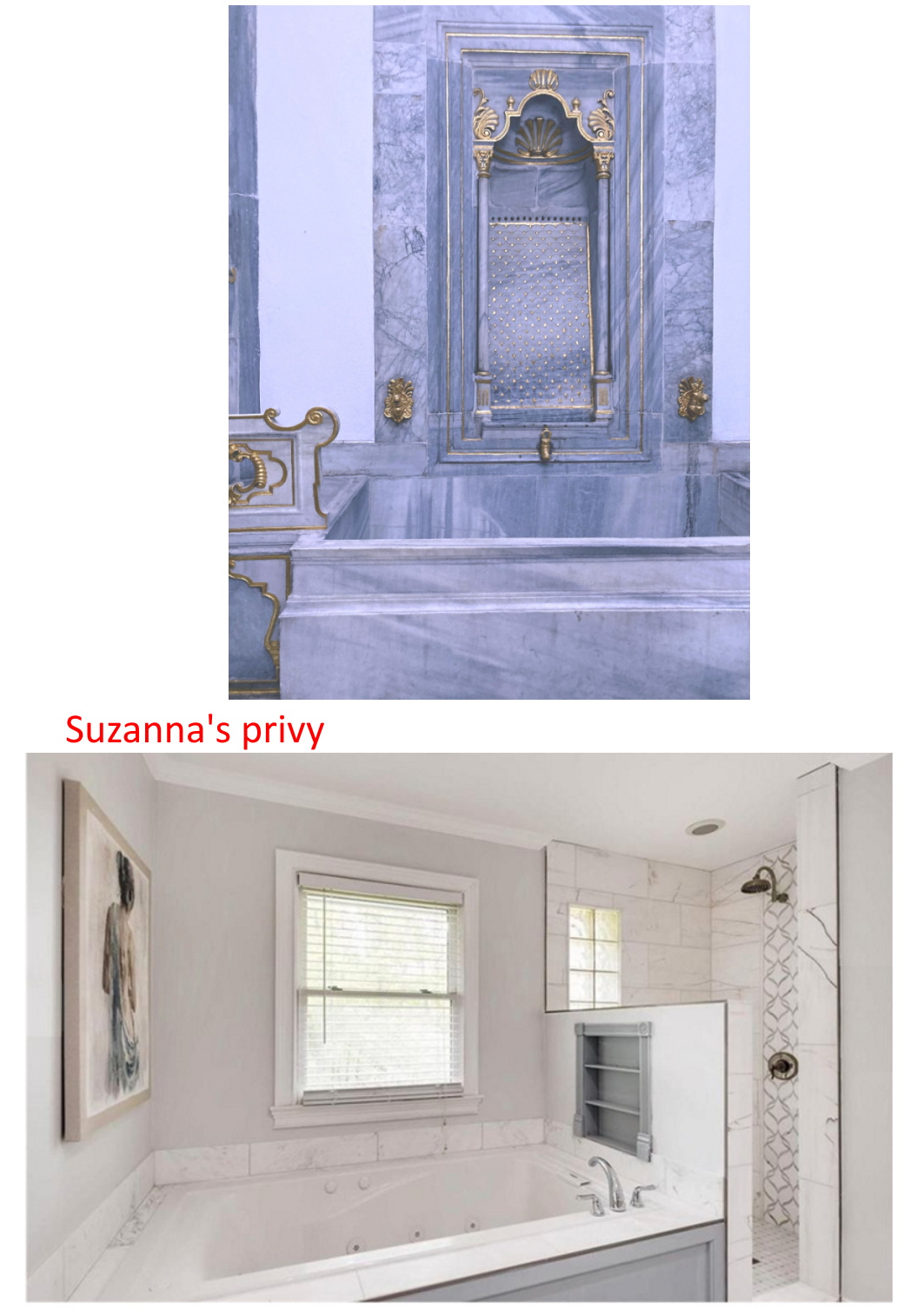
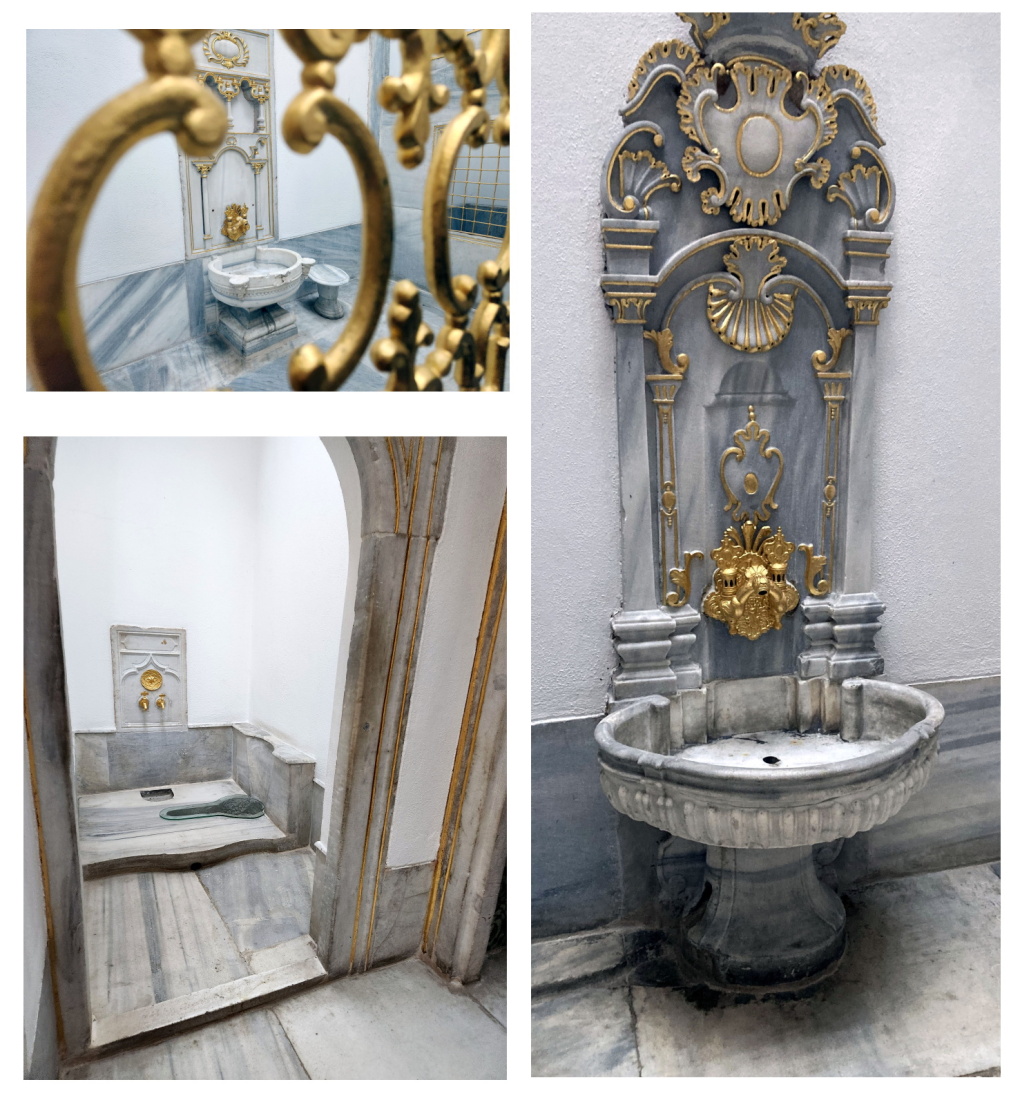
Comparable from the 1500's - another type of privy
.jpg)
American outhouses
.jpg)
Privies on the move:
.jpg)
11:05 now and we have free time on our own to see the Treasury, kitchens and collections until we meet again at 12:10.
I made a bee line to the toilet so Gary and I separated. Incredible that there was no line for the ladies toilet !
I do not think that my Grandfater it to Istanbul. What a magical place this palace is. I can’t imagine thousands of people living here back in the day.
11:10 and I’m going into the Imperial Treasury exhibit.
There is NO LINE to enter!
.jpg)
The Sign in front of the entrance says
(I reformatted the paragraph into a list.)
Imperial Treasury
On display in the Fatih (sic) Pavillion are Items from the Treasury Collection. One will find
precious royal heirlooms,
objects from state ceremonies (incl.sultanic symbols),
consular gifts exemplifying the Ottoman Empire's international diplomatic ties,
war booty, and
religious collateral reflecting the sultan's stature as a caliph.
Of particular significance:
the Spoonmarker's Diamond,
the Topkapj Dagger (a symbol of Topkapi Palace),
the Golden Throne (used for certain royal ceremonies)
and
jewel-encrusted artifacts sent to Medina for the Prophet Muhammad's tomb.
You walk by the swords, the jewels, and then the diamond.
Topkapj Dagger is a symbol of Topkapl Palace
Gold and jewels: Emeralds, Garnets, Ruby, Topaz, Sapphire, Diamond
Jewel encrusted box
.jpg)
You walk by the swords, the jewels, and then the diamond.
Topkapj Dagger is a symbol of Topkapl Palace
Gold and jewels: Emeralds, Garnets, Ruby, Topaz, Sapphire, Diamond
Jewel encrusted box
Spoonmaker’s Diamond
Most likely acquired by the Ottoman Palace Treasury during the era of Sultan
Mehmed JV 1648-1687(second half of the 17 th Century).
.jpg)
86 carats (17.2g) pear-shaped brilliant cut diamond
The most valuable single exhibit in the museum
The fourth largest diamond of its kind in the world.
Surrounded by a double row of 49 old-mine cut diamonds (brilliants)
Our guide called it the “super market diamond found in the trash. It was exchanged at the bazaar. 6 th largest diamond in the world. It is two times bigger than the Hope diamond (45 carats).
/p>
The tale of the naive fisherman
A poor fisherman found it in a pile of litter. He did not know what it was, and carried it for a few days.
He showed it to a jeweler who appeared uninterested, and told him "It is a piece of glass, take it away if you like, or if you like I'll give you three spoons."
He traded it for the spoons.
The "Topkapi" movie made this place famous in 1965.
Wiki said The Spoonmaker's Diamond is the big diamond that is referenced in the film, shot in Istanbul.
Stars Melina Mercouri and Peter Ustinov. However, the robbers depicted in the film are mainly oriented at stealing another Topkapi treasure, the emerald-encrusted dagger of the earlier Sultan Mahmud I.
Our guide also mentioned the movie Midnight Express. About trying to excape from
a Turkish prison
Jewel encrusted Korans
The Quran (Koran)
The central religious text of Islam:
114 chapters (surah) with individual verses.
Muslims believe
(I got this information from Wiki)
It is a revelation directly from God (Allāh).
Orally revealed by God to the final Islamic prophet Muhammad
through the angel Gabriel
over a period of some 23 years,
beginning when Muhammad was 40 to 63 when he died in the year 632.
It is Muhammad's most important miracle, a proof of his prophethood, and the culmination of a series of divine messages starting with those revealed to the first Islamic prophet Adam, including the holy books of the Torah, Psalms, and Gospel in Islam.
It is God's own divine speech providing a complete code of conduct across all facets of life.
%20HolyKoran2x.jpg)
Prayer beads and more jewels
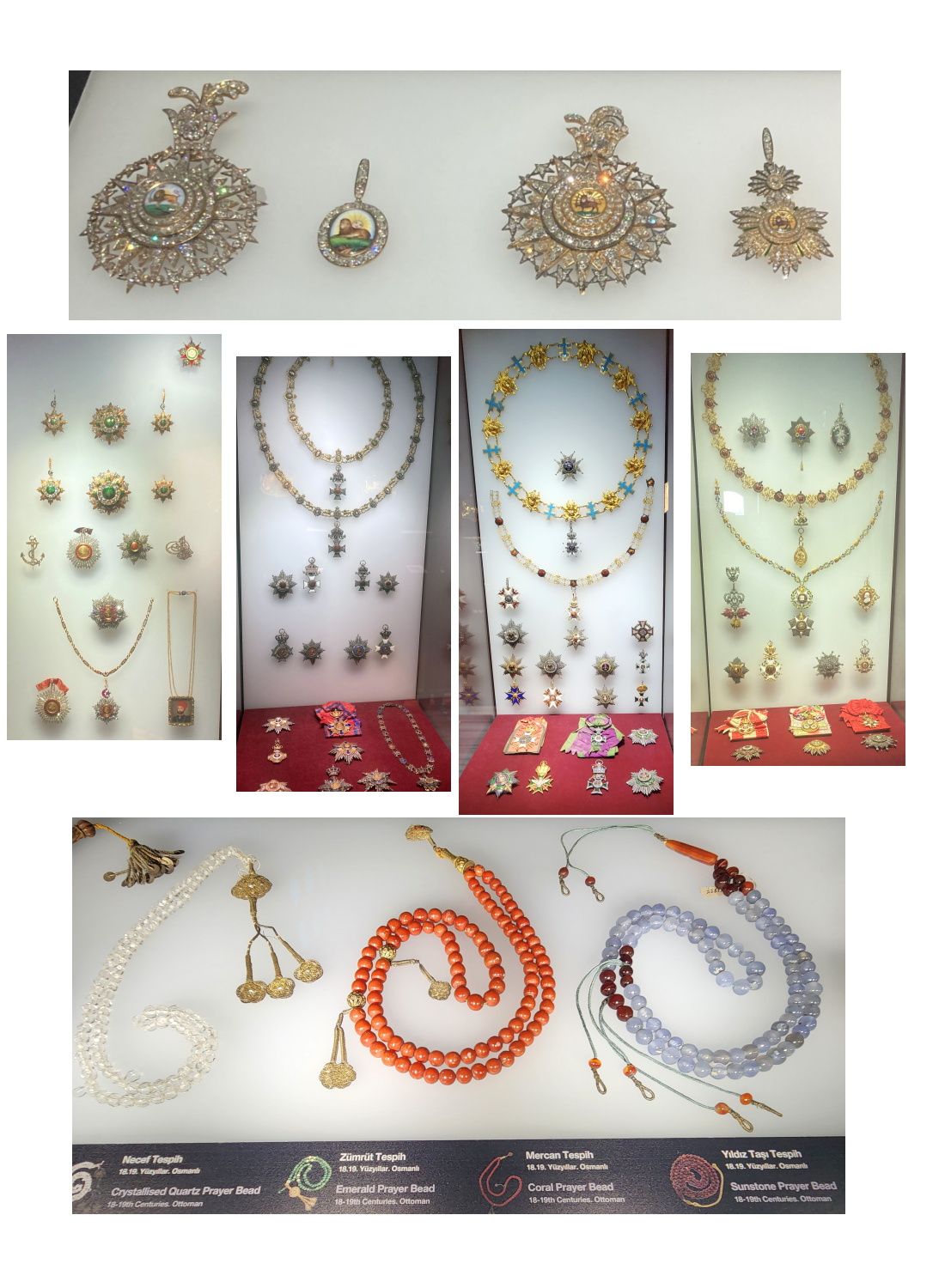
Armor and clothing
%20Armor2x.jpg)
.jpg)
.jpg)
After the Topkapi palace tour
They took us back to the hotel. I ate my cheese sandwich for lunch.
This afternoon we have the spice market tour, then a 2 hour cruise that ends at 6:45. Tomorrow is the last tour of the trip, then pack to go home!
Back to top
2:30 pm Bosphorus Cruise and Spice Market
Viking description of the Tour
2:30 PM 5 Hours Scenic Boat Ride and Fragrant Emporium
See Istanbul from the waters that divide Europe and Asia and visit a renowned spice market from the Byzantine era.
Embark on a short drive from your ship into Istanbul’s bustling Old City. Upon arrival, follow your nose to the famous Spice Bazaar, a covered market that has been the center of the city’s spice trade since the mid-17th century. Take a guided stroll through shops piled high with fragrant, colorful spices, plus Turkish Delight, mementos, and dried fruits and nuts.
Afterward, head to the bustling banks of the Bosphorus Strait, where you will board a local sightseeing boat for a scenic cruise along this historic waterway that separates two continents. Sail past Rumeli Fortress, a medieval hilltop fortification; see the eclectic blend of European and Ottoman influences that grace the grand facade of the Dolmabahçe Palace; and admire elegant Beylerbeyi Palace, the former summer residence of the sultan.
Spice Market - See
Grand Bazaar and Spice Market below.
Spice Market Carts
These carts were in front of the
Spice Market. I also saw carts like these in other spots around Istanbul.
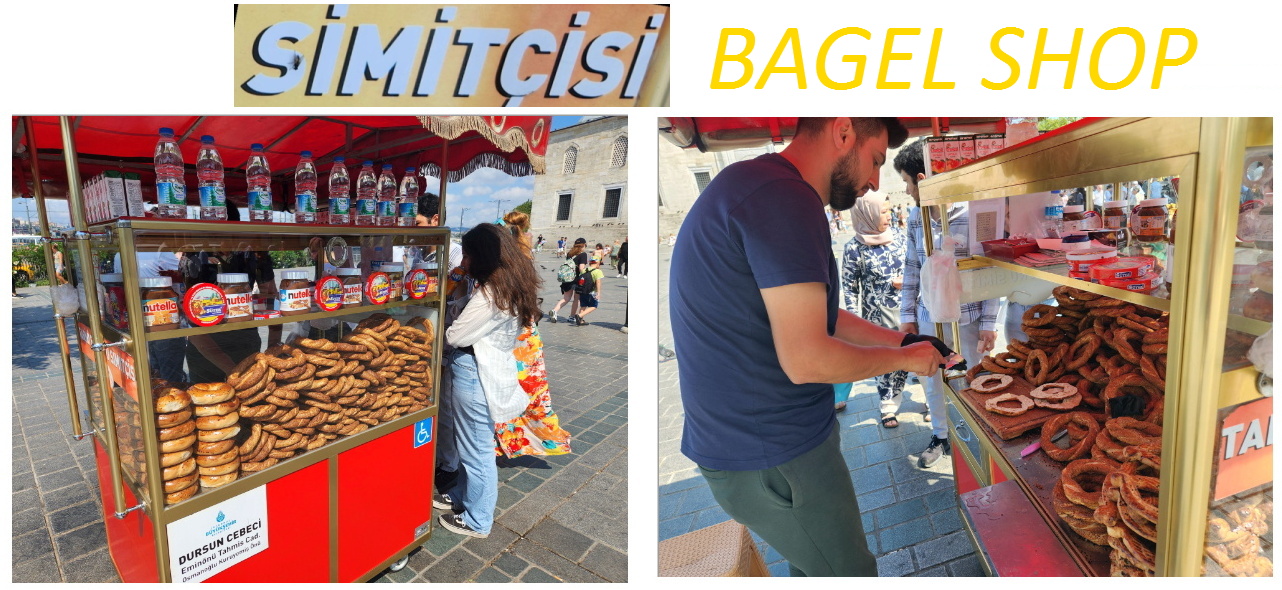
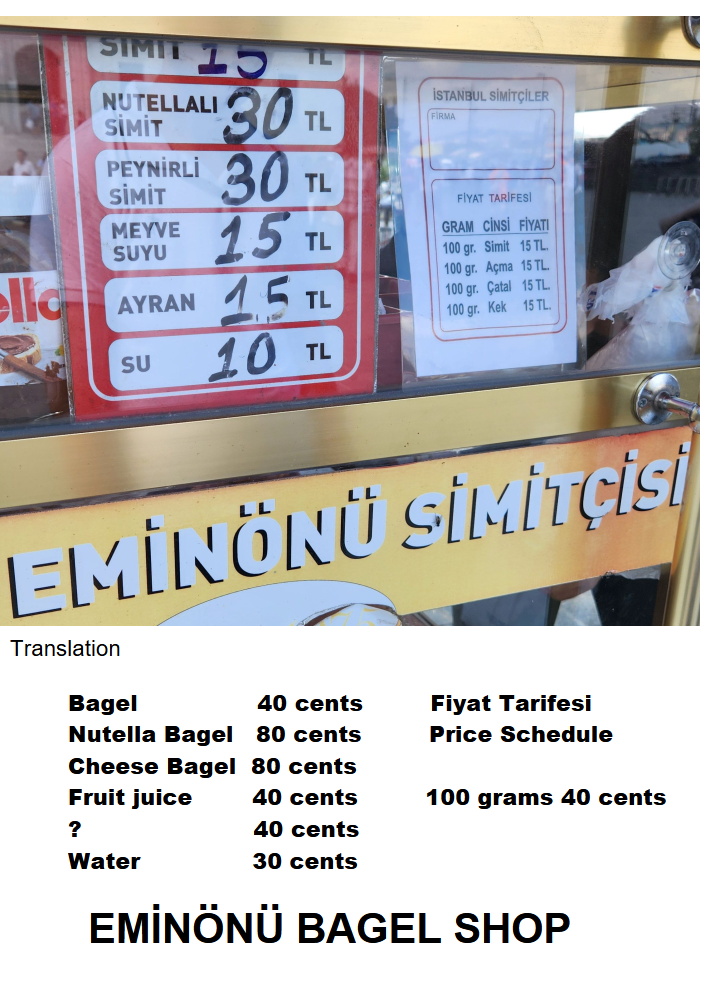
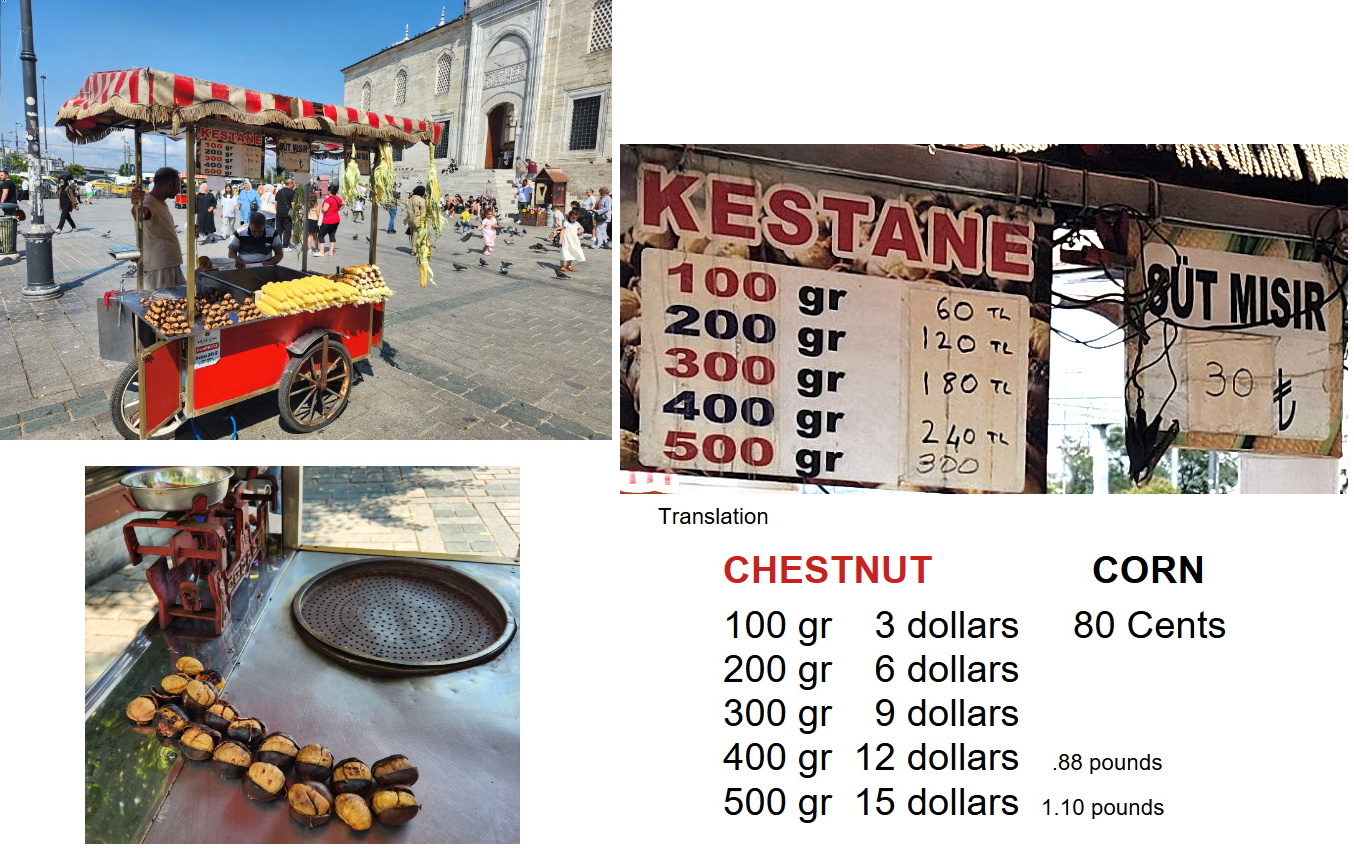
mw
After visiting the spice market we boarded our boat for a cruise up the
Bosphorus strait.
Back to top
Cruise
From 4-6 pm we were on a private yacht cruising. He said we will see 10-20 million
dollar houses.
It is 88 degrees
and there is a strong wind here on the top deck of our boat, I mean yacht . Perfect day to sail, I mean cruise.
We are cruising
on the The Bosphorus strait.
The strait is 150 to 300 feet deep of salt water.
This international waters. But during war time, Turkey and NATO controls the Bosphorus Strait.
There is a metro line UNDER the Bosphorus Strait water!
One tunnel takes five minutes to cross from one continent to another.
You can also cross the strait in public ferrry for 50 cents. It takes 10
minutes.
2 million people use the ferries every day.
Sometimes there is so much wind, the ferry are canceled.
There is no beach on this strait but some try to swim in this strong current.
The bay froze in 17, 18 century.
In 19 hundreds, 5 miles of the strait used to freeze But it does not freeze any more.
This is my picture of the Bosphorus strait. I took this photo from our hotel.
.jpg)
The Bosphorus strait during the 1787 war
.jpg)
Our private yacht for the Bosphorus cruise.
The cruise starts in the Golden Horn. The bay is 5 miles long but we start the
cruise near where it goes into the
Bosphorus which goes for 20 miles out to the Black Sea.
.jpg)
.jpg)
My picture of the Blue Mosque with 6 minarets.
.jpg)
Wiki picture with details that I added.
Old Istanbul peninsula in background, Galata neighborhood in foreground
Galata Bridge goes over the Golden Horn waterway
- it connects new Europe to old Europe. Unesco rules don't allow any
changes in old Europe.
Golden Horn connects to the Bosphorus
Bosphorus is 20 miles long
and connects the Black Sea to the Sea of Marnara.
Marnara means "marble".
Sea of Marnara is behind the peninsula in the picture below. It is an "inner
sea". There are only Turkish cities on this sea.
Sea of Marnara connects to the Aegean Sea.
Aegean Sea goes to the Mediterrean Sea
Also see the maps above.
.jpg)
My picture below shows our Conrad hotel and the Dolmabahçe Palace
built in 1853.
In 1853 Sultans moved from Topkapi Palace to Dolmabhadce (dol-ma-bah)
Construction cost was five million Ottoman gold lira, or 35 tonnes of gold, the equivalent of ca. $1.9 billion in 2021 gold values.
The palace was ordered by Sultan Abdülmecid I and designed by Garabet Balyan.
We also saw many 10 and 20 million dollar buildings along the show on our
cruise.
.jpg)
We cruised close to the European side, then turned around and came back closer
to the Asian side.
We went under two (or all three?) of these bridges:
15 July Martyrs Bridge (Bosphorus Bridge), the first to be built across the
Bosporus, completed in 1973. One mile long, 185 feet high.
Fatih Sultan Mehmet
Bridge, the second bridge crossing built in 1988, looking from the Asian side
towards Rumelihisarl on the European side of the Bosporus. One mile long.
Yavuz
Sultan Selim Bridge, the third and most recent crossing, in September 2016. The
bridge was opened on 26 August 2016.
Once a year there is an opportunity to swim across the Bos Strait. It is open for about 6 hours to swim the 1 or 2 miles across.
We got on yacht near the Golden Horn, but got off at a different location where
the bus was waiting to take us back to the hotel.
Back to top
Day 13 - Istanbul, Turkey - Blue Mosque, Hagia Sofia, Hippodrome, Grand
Bazaar
.
Another excellent breakfast
at the Hotel Conrad this morning.
9:00 am Blue Mosque, Hagia Sophia, Hippodrome Guided Tour
Viking description of the tour
Istanbul Old City Tour with the Hippodrome of Constantinople, “Blue Mosque” & Hagia Sofia
9:00 AM 4 Hours Iconic Landmarks of Byzantine and Ottoman Empires
Discover three of Istanbul’s most impressive and legendary landmarks during a walk through the historic Old City.
Visit the former site of the legendary Hippodrome, once the largest chariot racetrack in the Byzantine Empire.
See the Egyptian obelisk imported by Emperor Theodosius, the Serpentine Column from the Temple of Apollo at Delphi and more.
Head to the iconic “Blue Mosque,” or Sultan Ahmed Mosque. Marvel at its slender minarets and cascade of domes, one of Istanbul’s most recognizable sights.
Take a guided tour of its lavish interior, decorated with blue İznik tiles that give the building its nickname.
Explore the famous 6th-century Hagia Sophia, a former cathedral and mosque renowned as the embodiment of Byzantine architecture with its central dome;
at the time of its construction, it was the world’s largest building. Admire the golden tiles and masterful frescoes within, as well as the dome which seems to hover weightlessly overhead.
My Notes
It is 9:10 am and we are on the bus.
Our guide is Unal.
“Gunidin” is Good Morning
Today we see the iconic landmarks of Byzantine and Ottoman Empires.
There are no cruise ships here today so very few tourists. We are very
lucky.
Our original Viking itinerary said we were going to Blue Mosque then Hagia Sofia, but our excellent guide knew better and we went to Hagia Sofia first.
Our schedule:
1.
First visit
Hagia Sofia. Half museum in the upper gallery, and half mosque on the lower level.
July 2020 is was converted to a mosque. 2023 half mosque, half
museum.
2.
Walk 5 minutes and we arrive at the Blue Mosque. Renovated for 3 years and
finally reopen to the public last year in 2023.
3.
Walk 1 minute to the Hippodrome.
4. Grand Bazaar
5. 3:30 back to the hotel
99% of the population in Turkey is Muslim. In Istanbul, there are 3000 mosques!
There is a 5-minute Arabic call to prayer 5 times a day:
4:30 am first prayer in the summer, 7 am first prayer in the winter.
1:15 second
5:15 third
8:30 fourth
10:30 last
On Friday there is an additional 12 noon call to prayer to come to mosque with Imam.
Pray by kneeling and facing Mecca.
The length of your prayer depends on you. 5 minutes or an hour, your choice.
At the mosque they pray for about 30 minutes to one hour. Our guide said “A Jet Imam” has 5 minute prayers.”
They pray in Arabic (not Turkish). Most Turkish people do not know Arabic language. Our guide said “Imagine praying and you don’t know what you are saying.”
There are no memberships for a mosque. You can go to any mosque.
On our walk to the Hagia Sophia entrance
We pass a Hamman (a Turkish bath).
90 Euro to 180 Euro depending on the package. Our guide said it took him 3 days to recover from deep tissue massage.
There was a dress up shop. For 5 euro you can become a sultan!
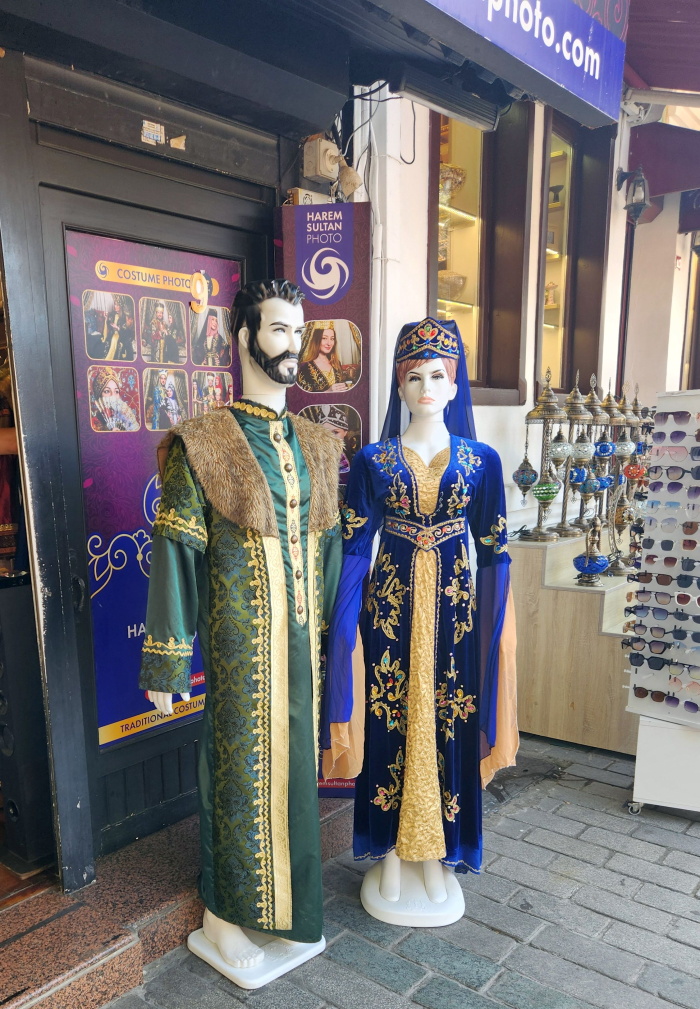
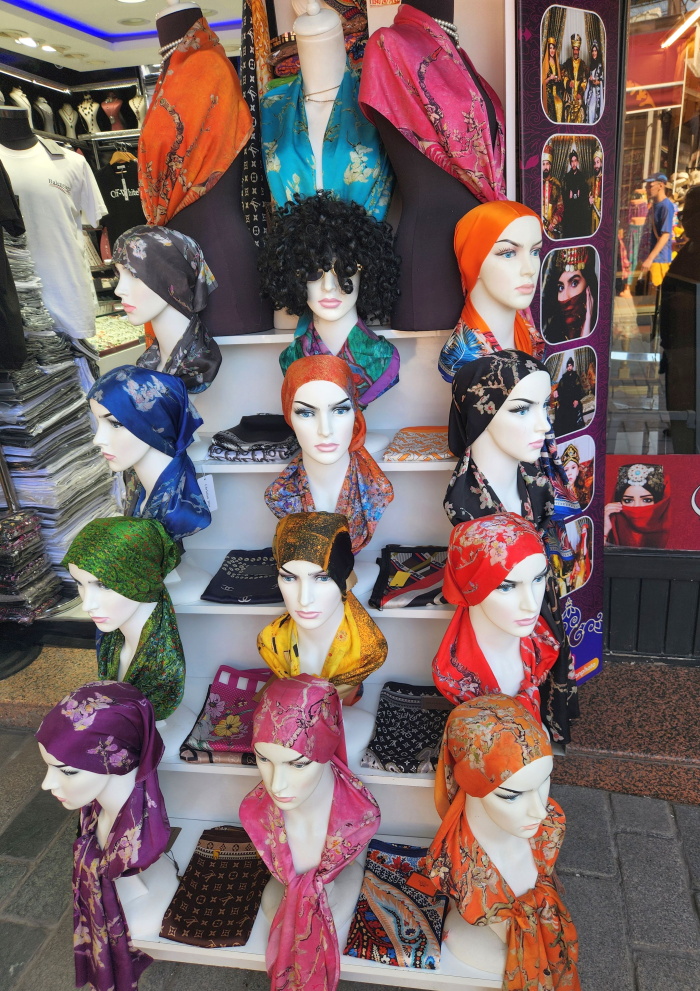
Ablutions
before going into the mosque
Ablution is washing of part or all of the body.
Muslims believe that showing respect for the Almighty includes ritual purity through washing.
During ablution, a Muslim washes the parts of the body that are generally exposed to dirt and grime.
.jpg)
.jpg)
.jpg)
Back to top
Hagia Sophia aka Ayasofya-i Kebir
Cami-i Serifi
Haga Sophia means Holy wisdom.
There are four minarets.
Note the renovation scaffolding on one of the minarets.
.jpg)
Church then mosque then museum then mosque then mosque&museum in 2023.
History
AD 360 to 1453 (1093 years) An Eastern Catholic church
FYI: An Eastern Catholic church traces their origins
to Christian bodies in the East but have established union with the Roman
Catholic Church
Built 3 times in the same place:
346 begin building,
360 dedicated the first church
Commissioned by Constantine I (272-337, Roman emperor who converted to Christianity and
moved the Roman empire's center to Contantinople)
Consecrated by his son Emperor Constantius II (r. 337–361).
It burned down in 404.
415 a second bigger church was inaugurated.
People against the emperor burned it down in 532. The whole church was a charred mass of ruins.
532 started construction of the current structure
537 (10,000 workers, 5 years and 10 months after construction started) the Christian cathedral
of Constantinople opened by the Byzantine emperor Justinian I .
The world's largest interior space for a thousand years, until the Seville Cathedral in Spain was completed in 1520.
The world's first to employ a fully pendentive dome.
In architecture, a pendentive is a constructional device permitting the placing of a
circular dome over a square room. A pendentive is a triangular segment of a sphere, it tapers to a point at the bottom and spread at the top to support the dome.
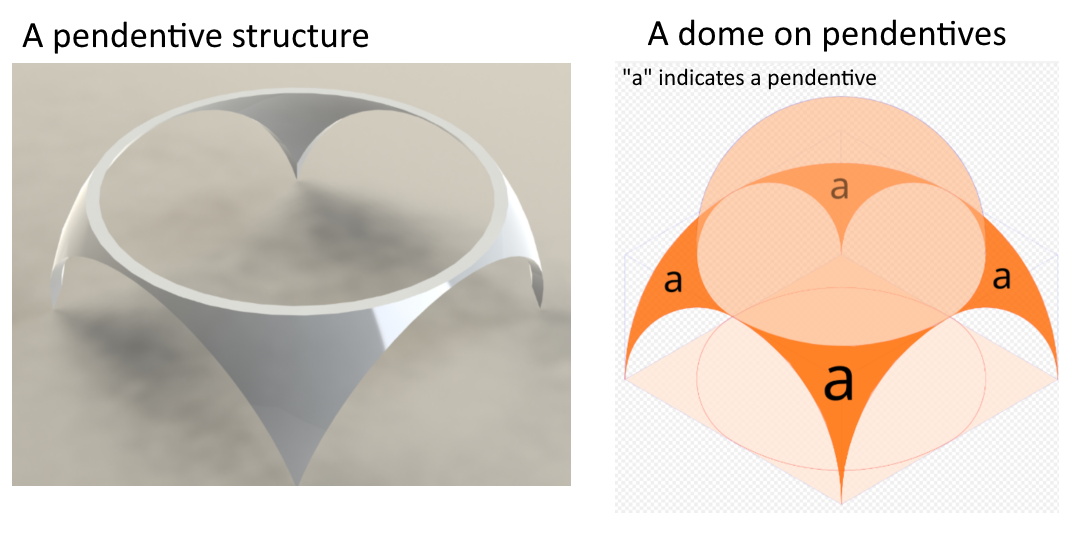
It is considered the epitome of Byzantine architecture and is said to have "changed the history of architecture".
Hagia Sophia became the quintessential model for Eastern Orthodox church architecture, and its architectural style was emulated by Ottoman mosques a thousand years later.
The Hagia Sophia served as an architectural inspiration for many other religious buildings.
including the Hagia Sophia in Thessaloniki, Panagia Ekatontapiliani, the Şehzade Mosque, the Süleymaniye Mosque, the Rüstem Pasha Mosque and the Kılıç Ali Pasha Complex.
As the religious and spiritual centre of the Eastern Orthodox Church for nearly one thousand years, the church was dedicated to Holy Wisdom.
The church has been described as "holding a unique position in the Christian world", and as "an architectural and cultural icon of Byzantine and Eastern Orthodox civilization".
In 1054 The East-West Schism when Patriarch Michael I Cerularius of
Constantinople was excommunicated from Pope Leo IX. Catholic Church and
Eastern Orthodox Church broke apart.
1204 Latin Catholic church (under the Latin Empire) after the Fourth Crusade
Enrico Dandolo, the doge of Venice who led the Fourth Crusade and the 1204 Sack of Constantinople, was buried in the church.
1261 Restored to the Eastern Orthodox Church under the Byzantine Empire.
1453 to 1935 (482 years) Hagia Sophia was a mosque.
1453 Ottoman Empire Sultan Mehmed II conquered Constantinople.
This was the beginning of the Ottoman Empire (which lasted until 1922).
Hagia Sophia became a mosque. Minarets were added. 2,400 shops, 1,300 houses, 4 caravanserais (lodging inn) were endowed to the waqf.
A waqf [pronounced "wahf"] is a charitable endowment under Islamic law. A building, land or assets are donated for Muslim religious purposes with no intention of reclaiming the assets.
Synonymous to eminent domain (with a payment) in our country.
Hagia Sophia was the principal mosque of Istanbul until the 1616 construction of the Sultan Ahmed Mosque (the Blue Mosque).
The patriarchate moved to the Church of the Holy Apostles, which became the city's cathedral. The complex remained a mosque until 1931, when it was closed to the public for four years.
FYI: Patriarchate [patre arket] is a term used in Christianity to designate the office and jurisdiction of an ecclesiastical patriarch.
Patriarchy, on the other hand, is a social system in which men hold primary power and predominate in roles of political leadership, moral authority, social privilege, and control of property.
Christian images/mosaics remained until sultan Suleiman I (reign 1520-1566) had
them plastered over. 1926 - 1935 renovations revealed images again.
1930 Electricity installed
1935 to 2020 (85 years) Hagia Sophia was a museum under the secular Republic of Turkey.
It was the most visited tourist attraction in Turkey in 2019.
1999 a 7.6 earthquake for 37 seconds. 20,000 died, 50,000 injured, 250,000 homeless. Haga sophia was OK
because it is built on a base of solid rock.
2020 Controversially redesignated as a mosque
The Council of State annulled the 1934 decision to establish the museum, and the Hagia Sophia was reclassified as a mosque. The decision was highly controversial, sparking divided opinions and drawing condemnation from the Turkish opposition, UNESCO, the World Council of Churches and the International Association of Byzantine Studies, as well as numerous international leaders, while several Muslim leaders in Turkey and other countries welcomed its conversion.
On July 10, 2020, Turkish President Recep Tayyip Erdoğan signed a decree announcing the conversion of Hagia Sophia to a mosque.
Carpet was installed on the ground bottom floor.
Curtains covered the images. The upper gallery was for ladies.
Photo from CNN article
https://www.cnn.com/travel/hagia-sophia-istanbul-hidden-history/index.html
5000 people pray on Friday

2024, January The upper floor of the mosque reopened as a museum.
Tourists pay 25 Euros to visit the museum on the second floor.
You go through a security xray
Hagia Sophia is 1487 years old (2024-537)
We are very lucky that there is no line to enter Hagia Sophia! There are no cruise ships in the
port today so very few tourists.
We are not allowed on the first floor (the mosque). We are going to the second
floor museum but we must still cover our head.p>
We walk up a wide ramp that goes around and around.
.jpg)
Only worshippers (no tourists) are allowed on the ground floor.
We are walked up to the second floor where you can see this:
.jpg)
The
mihrab - the niche in the wall that indicates the qibla (the direction of the Kaaba in Mecca towards which Muslims face when praying).
This marble mihrab was put in place of the Christian altar.
To the right of the mihrab is the marble minbar (pulpit) dating back to 16th
century.
Photo by Nomadic Niko when tourists were allowed on ground floor. The Virgin and
Child in the Apse was done in 867.
https://nomadicniko.com/turkey/istanbul/hagia-sophia/
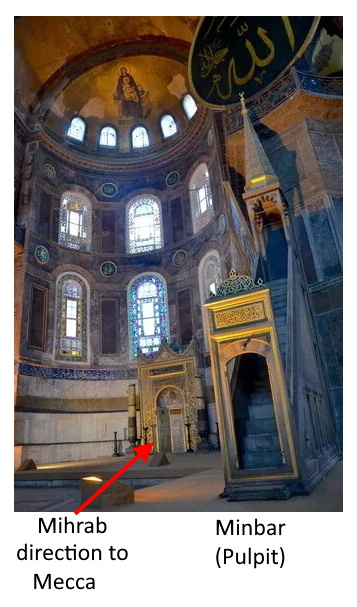
Dome and Curtains to cover
AD 360 - 1453 this was an Eastern Orthodox Christian church so images and
mosaics decorated the cathedral.
1453 - current it is Islamic mosque so the images
are covered. There are curtains that hide the mosaic because no images allowed
It is a mosque with Christian imagery. People on the ground floor can’t see the images because they are covered by the curtain.
The CNN article said "There is no other place on Earth
where Christian mosaics of saints and Byzantine rulers are juxtaposed with
Islamic calligraphy"
.jpg)
The dome
.jpg)
Curtains
.jpg)
Medallions
25 feet (7.5 m) in diameter
Contain the names of Allah
(God), the prophet Mohammed; the first four caliphs (the leaders of Islam after
the death of Mohammed) Abu Bakr, Umar, Uthman, and Ali; and Muhammad’s grandchildren Hassan and Hussein.
This was on Wiki, so I think one medallion says "Islam"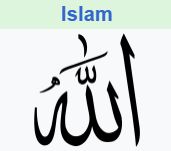
.JPG)
Columns
.jpg)
The giant Verd Antique marble columns
In the upper galleries columns are 15 and 16 feet tall.
On the ground floor, 34 feet tall including capitals and bases. The shaft is 28 feet tall.
Verd: A decorative facing stone. It is a dark, dull green, white-mottled serpentine, mixed with calcite, dolomite, or magnesite, which takes a high polish.
The basket capitals have carved with monograms of Justinian and Thedora
The Marble is from a quarry in Greece. It was transported via ships built to handle 350 tons of marble.
Or a 30 foot wide 118-mile road to transport up to a 45 ton heavy stone block.
Wagons were pulled by donkeys; oxen could not be used in the heat.
ss
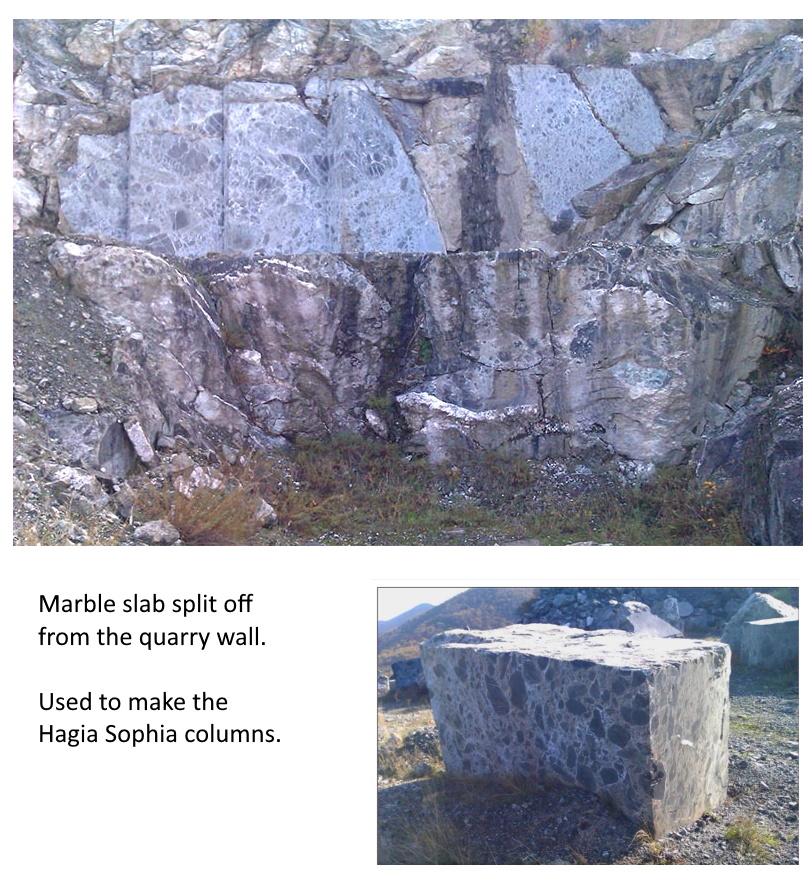
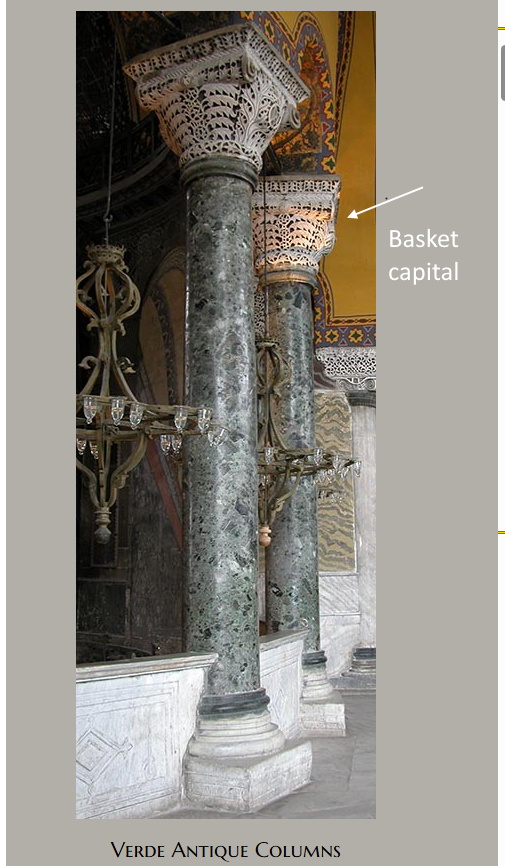
Lustration Urns on the west side of the nave.
Two huge urns carved out of a single block of marble.
Made around 330 BC and can hold 1,250 liters.
Used to distribute juice to worshippers during Islamic holidays and celebrations.
.jpg)
Mosaics
.jpg)
The outline of the cross is visible.
.jpg)
Mosaics in Hagia Sophia
Our guide said in 1935 mosaics were uncovered.
Yellow plaster is removed to see the mosaic. Gold
leaf mosiac is exposed.
These mosaics cannot be seen by the praying people on the first floor.
Deisis panel made in 1261: Virgin Mary, Jesus, John the Baptist
.jpg)
"MP" in upper left corner is "mother". "Ou" God so the inscription is mother of God.
.jpg)
Emperors donation mosaic panels
Left mosaic: Emperor Constantine IX Momomachos (third husband of Zoe), Jesus, Empress Zoe.
His purse indicates a donation, her scroll indicates her list of donations.
Right mosaic: Emperor John Komnenos, Virgin Mary, wife Empress Eirene (daughter
of King of Hungary), and son Alexios (co-emperor at age 17)
.jpg)
Walk down some wooden ramps and there is another mosaic.
Models of the City mosaic panel. There is a curtain above this image. The
curtain is lowered on Friday for services to cover the image.
As you exit there is a mirror where you can see the reflection of the image.
.jpg)
Models of the City mosaic panels
Left: Emperor Justanian I (who built Hagia Sophia) presenting a model of Hagia
Sophia
Middle: Virgin and Child
Right: Emperor Constantine (who established Istanbul) presenting a model of his
city
.jpg)
Back to top
Masoleum
Walk from Hagia Sofia to the külliye [pronouned "cull ee aay"] (it means "religious complex") which includes
Blue Mosque
Mausoleum for Ahmed I mausoleum, Ahmed I tomb
Madrasa (educational school) and other buildings.
Ahmed I was the 14th Sultan and he built the Blue Mosque.
Born in 1590. At 13 years old, he became sultan in 1603. He reigned for 14 years
until he died of typhus at 27 years old in 1617.
.jpg)
Burial of the Sulton with his 35 family members.
The coffin is symbolic. There are no bones. All bodies are buried underground.
Ahmed I is buried to the right of the building.
In 24 hours a dead body is washed, wrapped, they pray for it. The
body is taken out of the coffin and buried in the shroud only.
“The shroud has no pockets so you can’t take it with you”.
Wiki picture
.jpg)
We did not go into the mausoleum, but our group did stop
to take a picture of this Bentley police car. It was confiscated from the gangs.
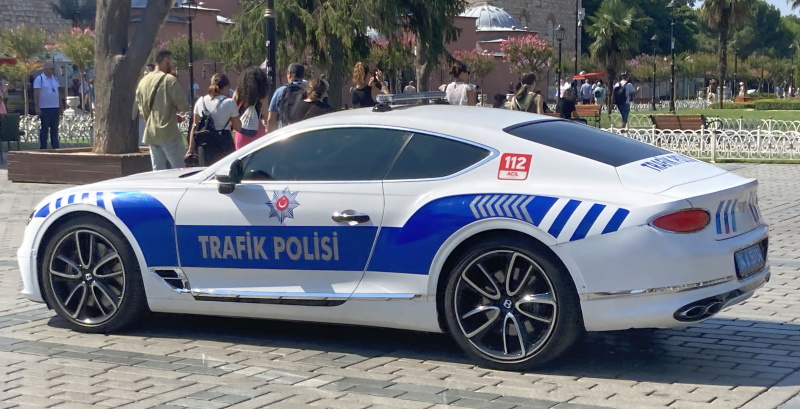
Back to top
Blue Mosque in Istanbul, Türkiye
The Turkish call it the Sultan Ahmed Camii (mosque)
An Ottoman-era historical imperial mosque
One of the most iconic and popular monuments of Ottoman architecture.
It was restored for 3 years and re-opened to public in April 2023.
Everyone is welcome, and it's free. If you need a head cover, they provide you one free as well.
You must remove your shoes which is respectful.
Check the times available for non-Muslim as it is an active Mosque.
Our guide said 12pm it is closed here so they can clean the place for the 1pm prayer.
Location in old Town Istanbul Türkiye within walking distance of Hagia Sofia, Turkish bath, Topkapi Palace.
This
is a Wiki picture
.jpg)
1609 - 1617 built by Sultan Ahmed I.
For 407 years, it is still a functioning mosque today in 2024.
It is about 200 feet from the Hagia Sophia and beside the Hippodrome. About 3 miles from Topkapi.
It has a classical Ottoman layout
A central dome surrounded by four semi-domes (half dome) over the prayer hall.
In front is a large courtyard and flanked by six minarets.
Inside decorated with thousands of Iznik tiles and painted floral motifs in predominantly blue colours, which is why we call it the Blue Mosque.
give the mosque its popular name.
The mosque's külliye (religious complex) includes Ahmed's tomb, a madrasa (educational school), and several other buildings in various states of preservation.
Here is the entrance to Blue Mosque. There is no line and we can walk right
in!
.jpg)
This is Gary's picture of the Blue Mosque taken on July 13, 2024.
This is the only mosque in Turkey with SIX minarets. Note one of the minarets
is covered in scafolding.
A mosque must have at least one minaret. More minarets
indicate a more prestigious mosque.
A mosque anywhere in the world cannot have more than 6 minarets because Mecca
has 7 minarets.
.JPG)
Here is a Wiki picture looking down on the Blue Mosque.
.jpg)
This Wiki picture shows the six minarets
.jpg)
There was NO LINE to enter the mosque.
Shoes are not allowed on the carpet so you have to take your shoes off. Our guide gave us a bag for our shoes. We carried our shoes with us.
If you put your shoes on this public shelf, I recommend: Do not put both shoes together. Put one shoe in one place and another shoe in another place. If both are together, it's easier for someone to grab them and walk off.
.jpg)
This is what you see when you enter. Wow.
.jpg)
Here we are pausing gawking to pose for a picture.
.jpg)
This wiki picture shows a good view of the interior.
There are four columns holding up the dome and they are called "elephant feet"
There are 3 in this picture.
.jpg)
My picture
.jpg)
My picture of the detail where they are restoring the colors.
.jpg)
Gary's picture of the dome
.jpg)
My picture
.jpg)
Wiki picture
.jpg)
Wiki picture
.jpg)
My picture
.jpg)
Wiki picture
.jpg)
Gary's picture
.jpg)
Detail of the Iznek tiles
.jpg)
.jpg)
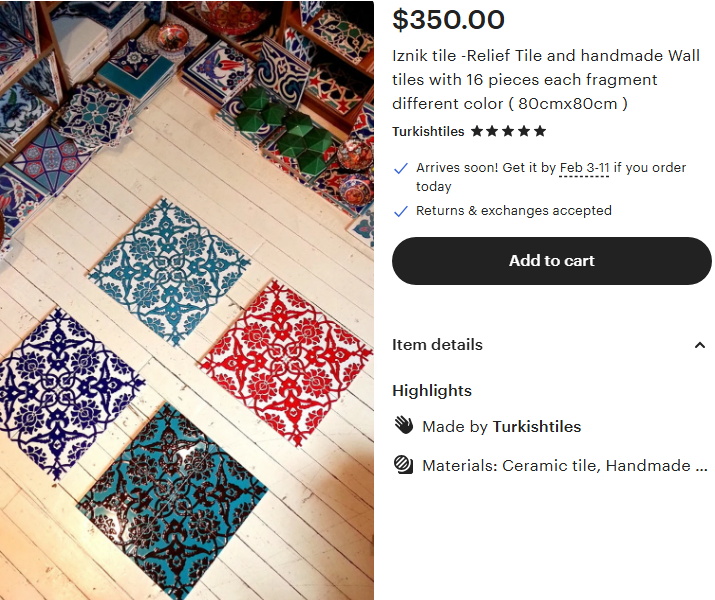
This Wiki picture shows the mihrab (center) and the minbar (right)
A mihrab is a niche in the wall of a mosque that indicates the qibla, the direction of the Kaaba in Mecca towards which Muslims should face when praying.
The wall in which a mihrab appears is thus the "qibla wall". The term mihrab is used to refer to any object, marking, or architectural feature that indicates the direction Muslims must face in the performance of the five daily prayers.
A minbar is a pulpit in a mosque where the imam stands to deliver sermons.
.jpg)
Praying area for women is a small corner of the mosque.
The men pray in the main area on the lower level of the mosque. Women on
the second floor or on lower level behind the fence a small corner at the back.
Our guide told us that "Turkish women are not required to cover, but covering is your choice of family background choice. Women wearing full black burkas are from another country. Not done so much here."
If it is the woman "time of the month" then they do not have to pray.
If pregnant, pray sitting down position (not kneeling)
.jpg)
There was a very small area where we put our shoes back
on.
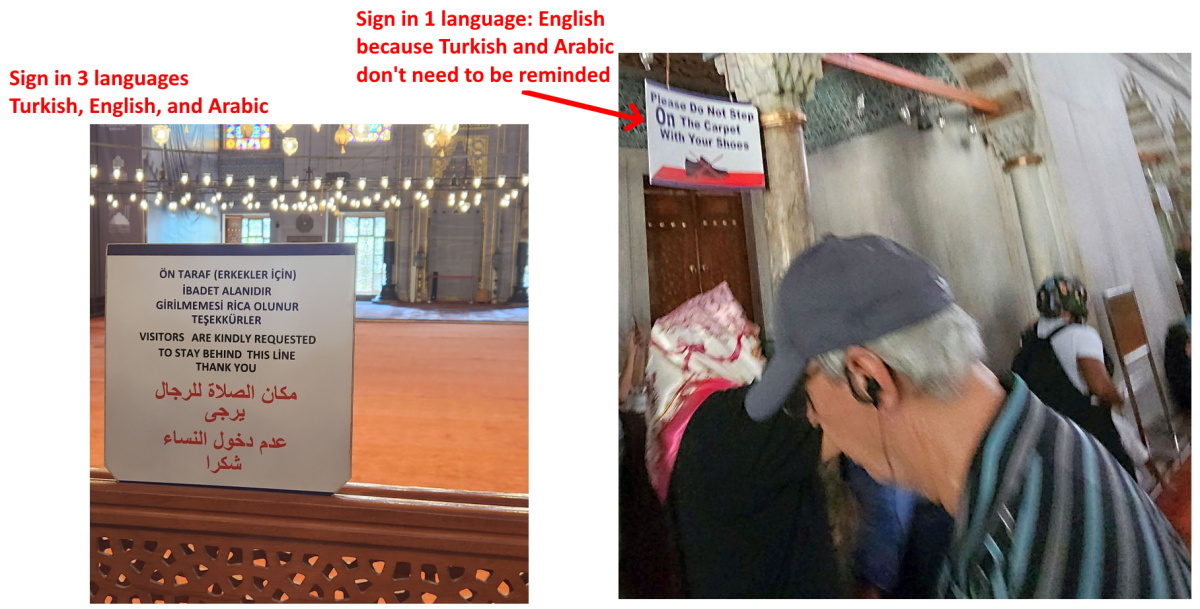
Back to top
Courtyard
The courtyard was almost empty!
We have 20 minutes of free time
until 11:25 for pictures.
What a beautiful day it is. It might be in the 80's. Our guide said it Bucharest was
104 degrees (39 C) today!
Ural, our guide was so informative. I had to tell him that every time he says
"Dear Guests" it sounds like he is saying "tear gas"
.jpg)
.jpg)
Back to top
Suzanna Travels writing the trip journal
.JPG)
Back to top
Dress Code
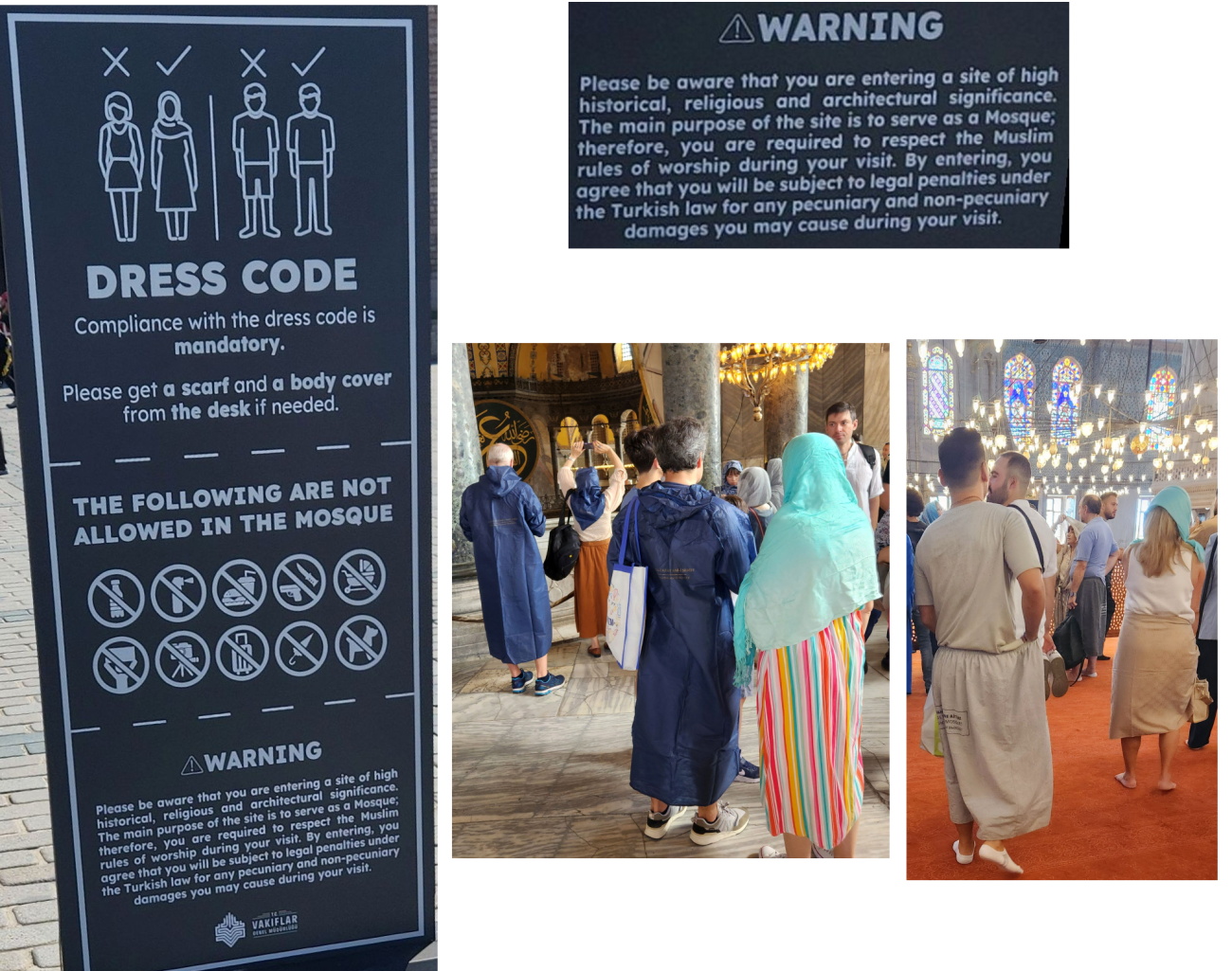
The sign says: WARNING
Please be aware that you are entering a site of high historical, religious and architectural significance.
The main purpose of the site is to serve as a Mosque; therefore, you are required to respect the Muslim rules of worship during your visit.
BY entering, you agree that you will be subject to legal penalties under the Turkish law for any pecuniary and non-pecuniary damages you may cause during your visit.
You must cover your knees and shoulders. Women must cover their head.
So if a man is wearing shorts, he must buy a covering. The 2 men in my photo above bought the body covering - a long plastic HOT cover with a hood. They realized they only needed to cover knees, so they took it off and wrapped it around their waist so knees are covered.
About covering
The Koran calls for both men and women to 'cover and be modest'. This reference to dress is open to interpretation and has been shaped by centuries of cultures in different nations.
There are many different reasons for covering.
It is a sign of modesty. Some women cover for cultural reasons, or some believe it is a religious obligation.
It can be a sense of pride, but unfortunately it can attract racism and misconceptions and assumptions prevail.
In France and Denmark, you cannot wear a garment that covers the face in public.
Different styles of headwear and Islamic veils that are worn by Muslim women around the world.
Hijab is the generic term used to mean cover your head leaving the face uncovered. It can be simple headscarf.
Burka is the most concealing. It has been worn by Pashtun women in Afghanistan and West Pakistan since pre-Islamic times, when it was considered a symbol of respect and stature in society.
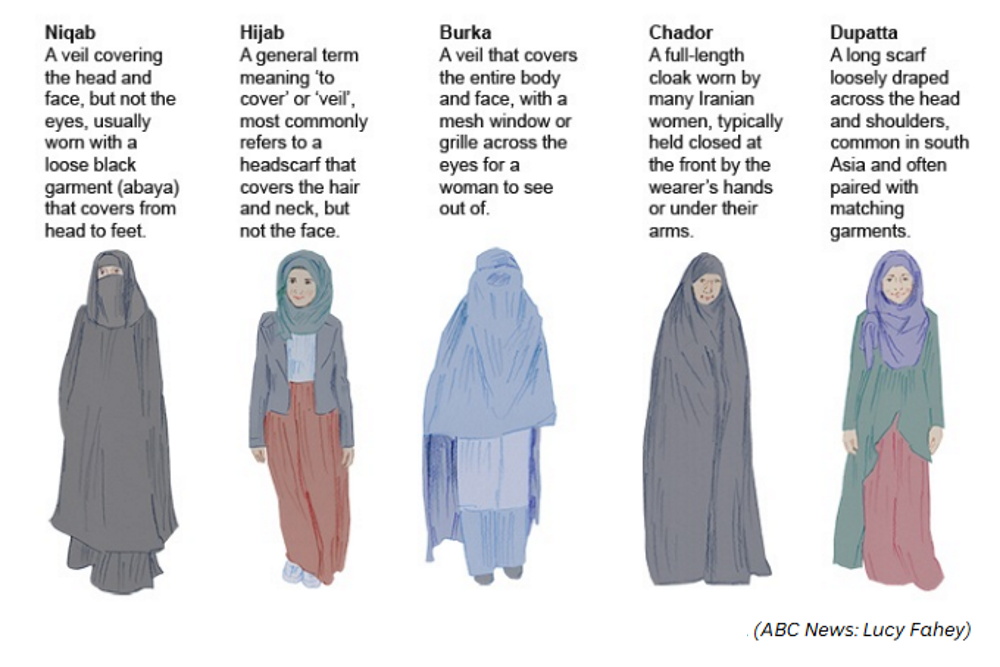
Back to top
After the visiting the Blue Mosque, you exit and walk over to the Hippodrome
Hippodrome of Constantinople
Greek:
Ἱππόδρομος τῆς Κωνσταντινουπόλεως,
Romanized: Hippódromos tēs
Kōnstantinoupóleōs
Latin: Circus Maximus Constantinopolitanus
Turkish: Hipodrom
A circus (an entertainment venue) that was the sporting and social centre of Constantinople, capital of the Byzantine Empire.
The word hippodrome comes from the Greek hippo (horse) and dromos (path or way).
Horse racing and chariot racing were popular pastimes in the ancient world and hippodromes were common features of Greek cities in the Hellenistic, Roman, and Byzantine eras.
Size Estimate is
1,400 ft (450 m) long and 400 ft (130 m) wide.
There is a secret tunnel under here to the palaces where emperors would escape.
This area was heavily looted.
Our guide said the stadium would seat 18,000 in the
audience
Obelisk of Theodosius in Sultanahmet Square
.jpg)
Above:
Karnak
110 feet was the original size, but it was too heavy so it was cut.
It took 51 years to get here.
One third of this oblesk is in egypt
Below:
To make the snake column Greeks melted the Persian sheilds and swords. In 476
BC. The oblesk was build here. From delphi temple in Greece.
.jpg)
Back to top
It took us 3 hours to see Hagia Sofia, Blue Mosque, and Hippodrome.
After the Hippodrome, at 12:30 we went to the Rug Shop.
and then the Grand Bazaar.
Rug Shop
Our guide said we would have an "old city tour" and here we are at an
old rug shop for a presentation. The shop is beside Otanic Karaca Kardelen Cafe.
This building is 400 years
old ! There are 2000 families in this co-op.
The courtyard behind the shop was a parking place for camels, and
now parking for Porche.
.jpg)
The weaving silk comes from a cocoon.
One cocoon yields 1 mile of silk. It takes 2 hours to unravel it. 10
strands together make the strongest thread in the world.
In the bazaar there is textile weaving area with a 30-minute presentation
in the co-op building of "weaving art" that starts with silk from the worm.
.jpg)
A master weaver. She works 4 hours a day and it will take 16 months
to finish the Tree of Life rug.
Turkey is the only place where they do double knot technique.
All other countries do a single knot.
Master weaver
.jpg)
We went down several winding stairs, through store rooms with 1000's of rugs in
inventory to go to the presentation room.
He took drink orders. Hot tea, hot apple tea, cold apple tea, beer, wine white or red.
.jpg)
.jpg)
After the rug shop we walked to the Grand Bazaar.
Back to top
The Grand Bazaar and The Spice Market
Before we went to the bazaar, our guide wanted to talk to us about Bazaar things.
Our guide explained that both places have the same things for sale, but you
really should see the Grand Bazaar.
Spice Market - We went here on Friday.
The Spice Market has 150 shops.
Our guide told us that if you don't have any alergies, to try everything that they offer you to eat at the Spice Market. Hazelnuts and more.
At the Spice Market he took us to a shop and they gave us tea in the traditional clear glass glasses.
No price negotiations at the Spice Market here.
Grand Bazaaar -
We went here on Saturday (after touring Hagia Sophia, Blue Mosque, Hippodrome and the rug factory)
The Grand Bazaar has 4000 shops. It is a labyrinth of colorful covered markets. It is very
easy to get lost.
200,000 people come to the bazaar every day. 30,000 people work there. Built in
1461.
There are no price tags. You ask what is the price, they give you a price depending on where they think you come from.
If you want to buy something, he told us to haggle. Negotiations is part of the culture. Offer a little lower price. Use Euro, dollar or credit card
(Visa, Mastercard ok. Maybe not American Express).
I was glad to see other people in our group made some purchases. I was sorry not to help their economy but I am at a stage in life where I don't want or need anything else. No more stuff and that includes souvenirs (except for my silver charm from each country).
.jpg)
There are 22 entrance gates.
We entered the
new section of the Grand Bazaar by the mosque through Gate 1
.jpg)
We walked through the gate to the old part of the bazaar. Walk slow, kill some time. Walk straight, no turns.
Walk till we get to another gate, turn around, walk back.
.jpg)
.jpg)
.jpg)
.JPG)
.jpg)
.jpg)
.JPG)
Turkish Eye Symbol / Turkish Blue Eye aka a Nazar (Eye) or Evil Eye
It has been around since ancient times, and over the years, it has become a strong symbol for the whole country.
The Origin Of The Evil Eye. History says, about 40% of the world's cultures believe in some form of the evil eye. There is mention of the evil eye in Roman and Greek texts, as well as the Quran and Bible.
The evil eye curse has a long history as far back as 3,000BC.
.jpg)
We walked back to exit the same gate where we
entered, then we sat on a bench. A vendor tryied to sell us perfume, rugs, a top that spins. No thank you.
After the bazaar we were bazaared out.
At 3:10 our group met at the Orient cafe. Walk to the bus back to the hotel.
Finally a chance to relax, shower, wash hair, eat my cheese sandwic.
Take sunset picture on the top floor.
I am glad we did NOT do this dinner cruise.
Our guide told us on cruise excursion tonight you do not eat on the boat. Go to a place where there are 200 tables for 1000 people to dine
This is another
optional tour that Viking also offered:
Dine with View Along the Bosphorus
$139 Person
7:00 pm 00 PM 3 Hours EASY MEAL AFTER DARK A Traditional Turkish Evening
Savor a traditional Turkish dinner as you take in the twinkling lights that line the Bosphorus Strait.
A busy trade route for centuries, the strait was once filled with old-world ships delivering spices and other wares to the city’s markets. Today, with Europe on one bank and Asia on the other, it remains an important international crossroads that has shaped the character of one of the world’s great cities. Meet your guide and embark on a scenic drive to your restaurant, along the banks of the Bosphorus Strait. Take your seat and sit back and relax as you prepare to embark on a tasting journey and sample a selection of delicious Turkish fare, full of the rich flavors inherent to this tasty cuisine. A range of delicious grilled meats, salads and other accompaniments will be served. Your appetite sated, enjoy an illuminated panoramic journey back to your hotel.
Back to top
Day 14 - Flight Home from Istanbul, Turkey to Atlanta
.
It is Sunday and we have our last breakfast on
vacation at the excellent breakfast
at the Hotel Conrad this morning.
I overheard a woman saying Atlanta
so I introduced myself and she is the Secretary consul form Atlanta to Turkey. I
agree with her that more people should visit turkey.
Mona Sunshine 404-245-9110
monadiamond@gmail.com
Hon. Consul of Turkey for Georgia
After breakfast:
I went in the lobby bathroom and there was a covered lady washing her hands.
I smiled and she smiled back. I figured this was my only opportunity so I had to ask her “where are you from?”
I have been asked that question several times. I hope she didn’t mind my inquiry.
She responded “Iraq”. Now I really wanted to know - so I asked her when America was in Iraq, was it better or worse?
She tried to communicate that it was worse (bad). She went to Dallas Texas for 2 years. Now she is back in Iraq living in Bagdad. I told her I am so sorry that happened when America was there. She didn’t like Bush either.
c
We put our bags out for pickup at 10:30 this morning. Check out of hotel.
Say goodbye to our awesome, knowledgeable guide Ural. And another guide Kursat and Aliey at the
hotel desk. Kursat wrote “Mashallah”
means wishes for good health good luck.
11:00 am departure from the hotel. Transport to the Istanbul airport for our
2:50 pm direct 12-hour flight to Altanta.
It took 45 minutes to drive to the airport with no traffic.
Our guide asked us if we noticed men with bandages on their head. Men come here for hair transplant. Cost is $15,000 in the US, but only 3,000 here in Turkey.
Turkish airline is “Turkish hairline”
2 pm and we were sitting at the gate waiting to board the direct flight home to Atlanta.
Before we got here, we were searched at least twice, passport check at least three times. Luggage opened twice. They confiscated both pairs of scissors (oops those should have been in my check luggage) Oh well.
I really did truly LOVE Istanbul and I would like to return again some
day.
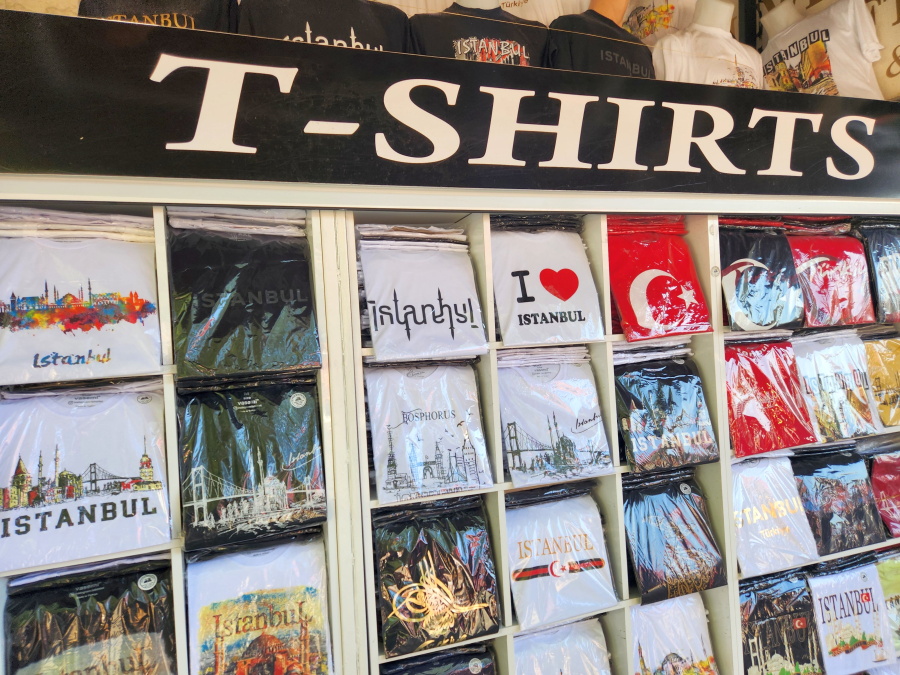
Back to top
..
This page and all other pages in the
http://www.mytrips.com web site, along with the journals, images, and photos are Copyright ©
2025 by Suzanna Travels. All publication rights are reserved. Email: web@
mytrips.com Remove the space after the @

.jpg)
.jpg)
.jpg)
.jpg)
.jpg)


.jpg)
.jpg)


.jpg)
%20ByFadiAswad.jpg)
%20wiki.jpg)
.jpg)
.jpg)

.jpg)
.jpg)
.jpg)
.jpg)


.jpg)
.jpg)
.jpg)
.jpg)
.jpg)
.jpg)
%20HolyKoran2x.jpg)

%20Armor2x.jpg)
.jpg)
.jpg)



.jpg)
.jpg)
.jpg)
.jpg)
.jpg)
.jpg)
.jpg)


.jpg)
.jpg)
.jpg)
.jpg)


.jpg)
.jpg)

.jpg)
.jpg)
.jpg)

.jpg)


.jpg)
.jpg)
.jpg)
.jpg)
.jpg)
.jpg)
.jpg)
.jpg)
.jpg)
.jpg)

.jpg)
.jpg)
.jpg)
.jpg)
.jpg)
.jpg)
.jpg)
.jpg)
.jpg)
.jpg)
.jpg)
.jpg)
.jpg)
.jpg)
.jpg)
.jpg)
.jpg)
.jpg)
.jpg)

.jpg)
.jpg)

.jpg)
.jpg)


.jpg)
.jpg)
.jpg)
.jpg)
.jpg)
.jpg)
.jpg)
.jpg)
.jpg)
.jpg)
.jpg)
.jpg)
.jpg)
.jpg)
.jpg)
